Fighting back for nature

How you can help
PLUS:
Spotlight on volunteers
Space4Nature
Gardening for wildlife
Donations help our heathland
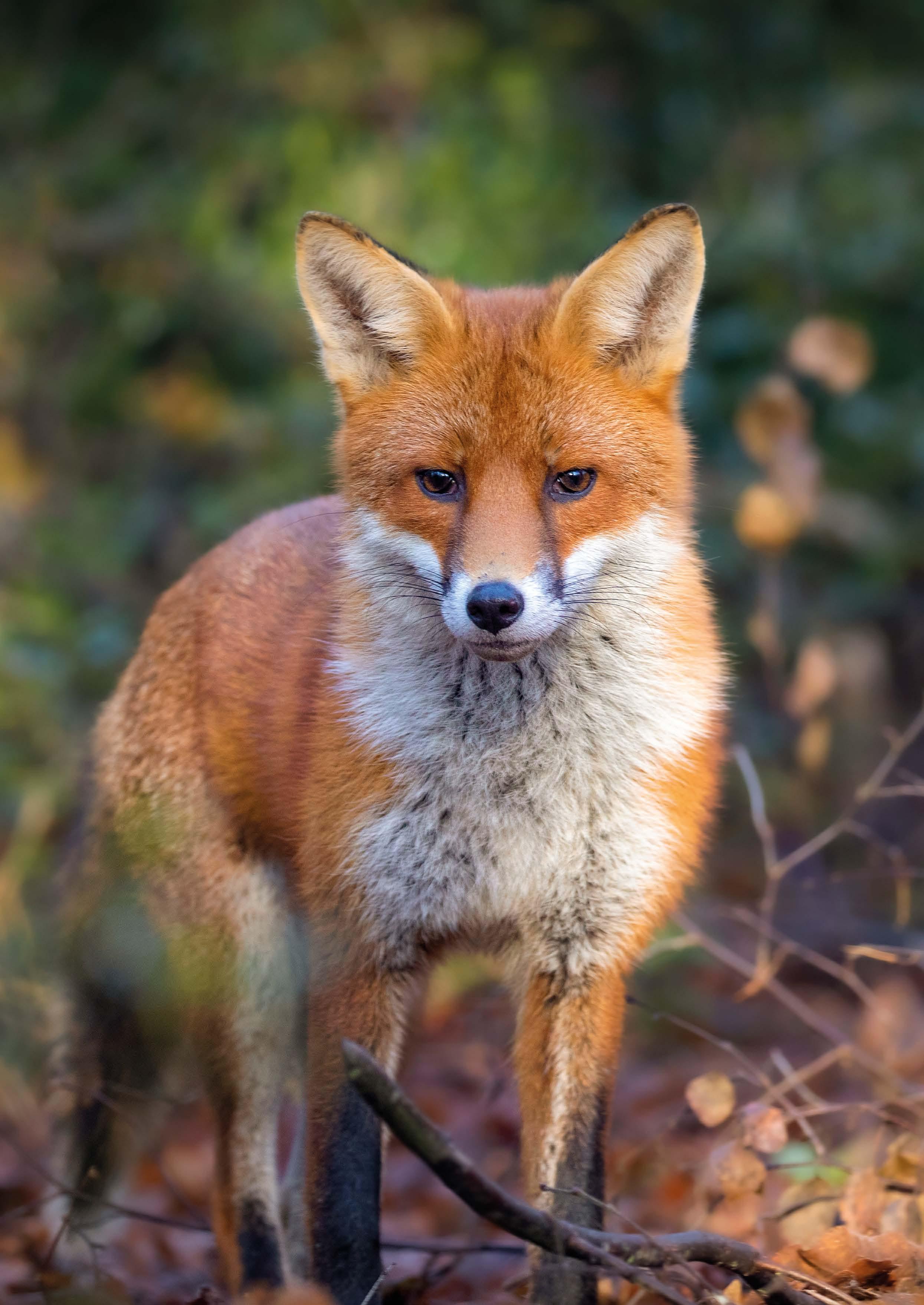
Wildlife Trust
Surrey


Scan to shop WINTER LANDSCAPE © BEN HALL/2020VISION 2
Surrey Wildlife Trust’s membership magazine, published three times a year. Surrey Wildlife Trust, School Lane, Pirbright, Woking, Surrey GU24 0JN.
T. 01483 795440 E. info@surreywt.org.uk
Editorial enquiries and contributions should be sent to the editor: Oliver Fry
T: 01483 795440
E: oliver.fry@surreywt.org.uk
© Surrey Wildlife Trust 2022
DESIGN
The Way Design
E: hello@thewaydesign.co.uk
W: thewaydesign.co.uk
WRITER
Simon Prichard
E: simon@zurito.co.uk
ADVERTISEMENT ENQUIRIES:
Sadie Miller
E: sadie.miller@surreywildlifetrust.org.uk
MEMBERSHIP
New memberships, gift memberships, change of address, change of bank details, cancellations and amendments should be sent to the Membership Department at the address above, or telephone the Membership helpline: T. 01483 795445
E: membership@surreywt.org.uk
CHARITY
Patron: Dame Judi Dench
Chair: Angela Swarbrick
Chief Executive: Sarah Jane Chimbwandira
Director of Finance: Roger Wild
Director of HR, Culture & Support Services: Catherine Roberts
Director of People Engagement: Aimee Clarke
Director of Reserves Management: James Herd
Director of Research and Monitoring: Mike Waite
Surrey Wildlife Trust is a member of the Wildlife Trusts Partnership.
Registered Charity No 208123
Registered Company No 645176
VAT No 791 3799 78
Cover image: Fox © Jon Hawkins
All images © SWT unless stated
FIND OUT MORE ABOUT OUR WORK:
Like us on Facebook

Follow us on Twitter
Find us on Instagram surreywildlifetrust.org
Join the fightback
Stop the government’s attack on nature
You may remember that the Conservatives were elected in 2019 on a manifesto pledge to deliver the “most ambitious environmental programme of any country on earth”. There was much to celebrate in this commitment, and over the last three years we have had many constructive conversations with MPs and ministers who want to see a more sustainable future for our country. Along with thousands of people across Britain, I was therefore extremely concerned by a series of recent proposals that threaten to put all this at risk.
Policies floated last month include:
n Creating a swathe of low-regulation ‘investment zones’ across the country with few planning or environmental rules, which risk putting habitats under threat from bulldozers and concrete, including nationally and internationally protected sites.
n A proposed new ‘Retained EU Law Bill’ to abolish all EU-derived rules – including the Habitat Directives – with no plans to replace them. This will remove essential protections for rare species and sensitive habitats, and expose wildlife to more disturbance, commercial development and pollution.
n Plans to discard proposals to pay farmers to look after nature and to farm more sustainably, returning us to a failed agricultural subsidy system where farmers are given taxpayers’ money based purely on how much land they own.
n Dropping the existing moratorium on fracking to potentially expose large areas of Surrey to air, water and sound pollution.
So what can we do? If we want our economy to grow and prosper over the long term, we must start working with, not against nature. Tearing up the laws that protect our wild places is precisely the wrong thing to do. Our system of planning and environmental rules has helped protect the precious rivers, meadows, woodlands and heathlands that provide us with clean air, water and food, and give an enormous boost to quality of life for people of all backgrounds and incomes.
I want to work with forward-looking MPs of all parties to persuade the government to drop these poorly conceived ideas and replace them with stronger action to protect our wildlife, our climate, and our futures. I’m pleased to say that in this regard, we have some strong allies in Surrey. You can find out more on our website surreywildlifetrust.org
Meanwhile, in this edition of Surrey Nature you can discover how the Trust is collaborating with a range of partners to create a wilder future for people and nature. And how you can make a real difference in your own community. Let’s get to work!

And finally, I’d like to express my warmest thanks to everyone who donated to our urgent appeal following this summer’s devastating wildfire on Pirbright Ranges. Your generosity will make a great impact in aiding the recovery of one of our most precious habitats over the years ahead.
Thank you.
Sarah Jane Chimbwandira Chief Executive
AUTUMN WELCOME 3
© Jon Hawkins
GIVE US YOUR BEST SHOT
Want to have your image featured as our next ‘Photo of the season’? Share your best photos of autumn with us. Email them to: oliver.fry@surreywt.org.uk or share them on social media: @surreywt #surreynature



24 THE WILD PARENT'S POCKET KIT 12 DADDY'S HOME FEATURES 8 Restoring nature by connecting habitats Space4Nature combines advanced technology with boots on the ground 10 Scrubbing up for wildlife Best-practice scrub removal 18 Members rally for Pirbright Ranges Wildfire appeal raises over £43,000 22 A garden in balance Delegate, delegate, delegate. REGULARS 3 Sarah Jane Chimbwandira 6 News 26 Corporate news 27 Introducing Billie Pearce NATIONAL 28 UK news 30 Beach babies 34 Rot property
GAMING FOR NATURE 20
IN THIS ISSUE...
4 AUTUMN CONTENTS
© David Clarke
KISSING HARVEST MICE

5
by David Clarke – an entry in this year's Wild Surrey photo competition.
AUTUMN PHOTO OF THE SEASON
OUR NEWS
Schools go wilder
Surrey schools have teamed up with SWT to make life better for pupils, teachers and wildlife.

The Wilder Schools initiative helps teachers embed learning about nature in the curriculum, while improving habitats in school grounds. Schools that have taken part this academic year include Royal Alexandra and Albert School, Oakfield Junior School, Croydon High School, Moor House School and College, Manor House Preparatory and Senior School, Bushy Hill School, Howard of Effingham School, Wray Common Primary, Eastwick Schools and George Abbot School.
At Oakfield, near Leatherhead, the school has worked with us since November 2020, designating and developing an outdoor classroom, carrying out nature audits of the school grounds, creating bug hotels, organising minibeast safaris, and running Action for Insects and River Health themed assemblies.
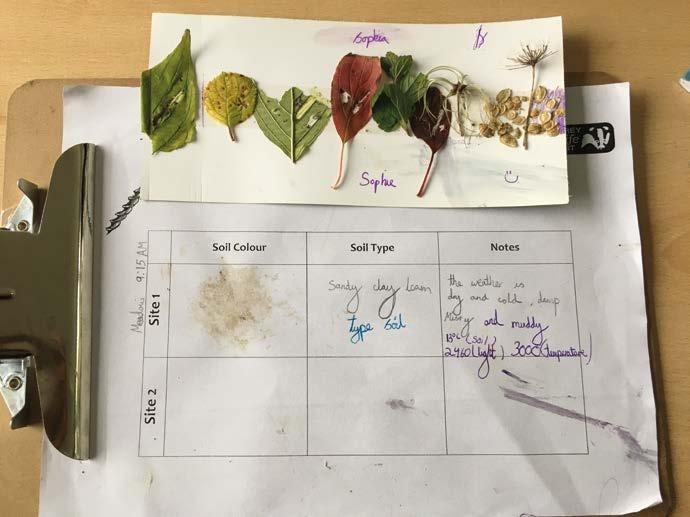
Julie Gumbrell, a class teacher at Oakfield says: “Focusing on taking responsibility for our environment and
not leaving others to take action was a particularly relevant and powerful message.”
At The Royal Alexandra and Albert School in Reigate, activities have included the creation of an outdoor classroom area, natural art classes, bramble clearance, hedge laying, habitat investigations and special sessions to work out how evolution has acted on local species.

Head teacher Shaun Greenwood says:
Twelve new schools have joined the Wilder Schools programme starting this autumn. You can find out more at surreywildlifetrust.org/ wilder-schools
SWT outdoor learning manager Louise Shorthose adds: “Children shouldn’t see the natural world as something that is separate from them. Instead, it should be part of who we are and what we do throughout our lives.”
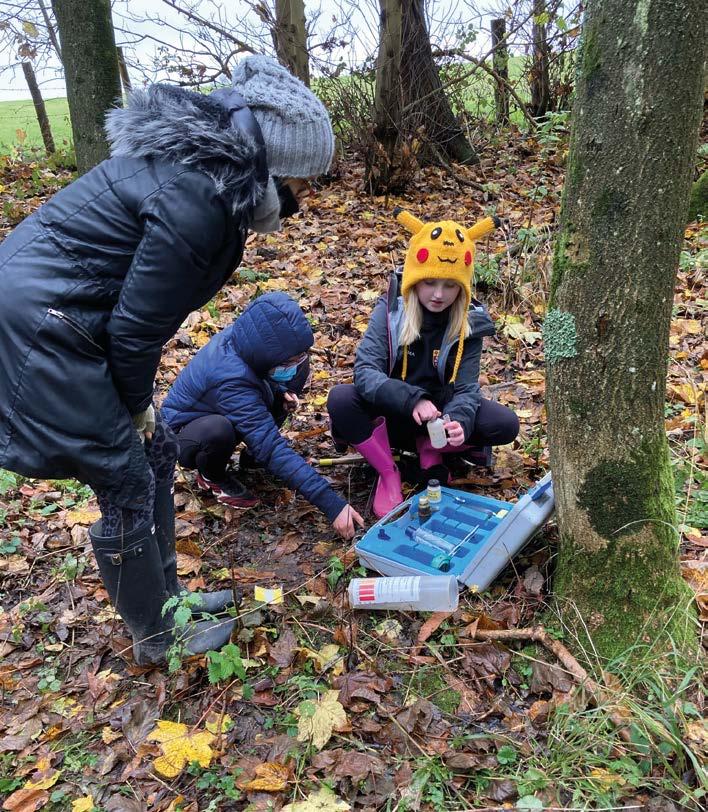
"The excitement from pupils when finding out they have an outdoor learning lesson is tangible – and the feedback from parents is equally positive."
6 Collecting habitat data AUTUMN NEWS
SWT at Pride
During the gloriously sunny summer bank holiday weekend, SWT took part in Surrey Pride 2022. We marched through Camberley town centre alongside the likes of Surrey County Council, the NHS and Surrey Police, in the largest parade in the event’s history. Staff and volunteers waved colourful flags and kites and dressed in wildlife-themed rainbow outfits.
“It was a fantastic way to support and celebrate our staff, volunteers and members who are part of the LGBTQIA+ community,” said SWT director Aimee Clarke.
“It’s our responsibility to make sure we are championing diversity and uniqueness in our own community, just like we do for nature. We’re already planning how to be even more fabulous at next year’s event and encourage any of our members and volunteers to join us in the 2023 parade.”
Wild Youth is coming
At the beginning of September young people and youth workers from across the UK came together to plan the Wildlife Trusts’ first ever Wild Youth festival, to be held in summer 2023.

With the help of staff from different Wildlife Trusts, they had the opportunity to express their views on the festival, considering questions such as how nature makes us feel, what makes a festival green and what media coverage it will get.
Visualisations, informal chats and even an outdoor meditation generated hundreds of ideas. Marshmallows around the campfire
and an optional zipwire were inspiring in their own way too.
On the final day, the various groups presented their ideas by creating a “festival in a box”, with the perfect festival ingredients on the outside and activities on the inside. The most popular ideas included green transport links, experiential nature, sustainably powered music, ethical vendors, and a big theme to bring people together. All under the banner of “Hope is in Our Nature”.
The group is now gathering feedback from even more young people across the movement and making plans for the festival itself. Watch this space and keep your diary clear!
Many UK Wildlife Trusts took part in their local pride events this year, co-ordinated by the pan-Trust Out for Nature network, which is the internal staff LGBTQIA+ group. Taking part in Pride and other events plays an important role in turning the federation’s Wild About Inclusion policy from words into action.

Thank you, Simon!
Congratulations and a huge thank you from all at SWT to Simon Humphreys, Voluntary Reserve Manager at Dawcombe and Fraser Down, who is celebrating 40 years with the Trust. Simon and his committed group of volunteers have worked tirelessly to transform these chalk grassland reserves. (You can read more on pages 14-16.)
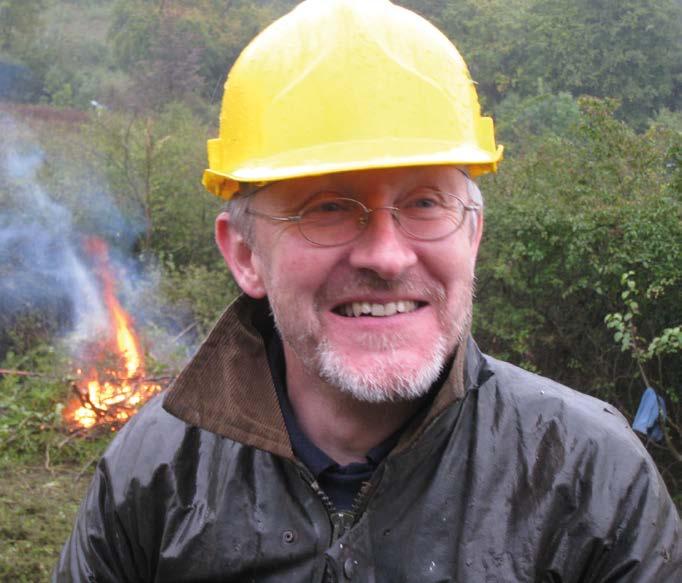 Wild Youth team © Laura Ashfield, SWT
Wild Youth team © Laura Ashfield, SWT
7 AUTUMN NEWS
RESTORING NATURE BY CONNECTING HABITATS
Space4Nature combines advanced technology with boots on the ground
Andrew Jamieson, SWT Space4Nature project manager
In the summer issue of Surrey Nature we announced big news for conservation and land management in Surrey – and potentially nationwide. A £1.25 million grant from The People’s Postcode Lottery Dream Fund will support a three-year Space4Nature programme that uses the latest satellite imagery and artificial intelligence (AI) to map and analyse habitats across the county.
Once this technology has identified individual habitats of interest, volunteers and community groups will carry out detailed checks on the ground to establish which species are currently present and how we should intervene. This will enable SWT to work on our own land, with other landowners and with public bodies to create, restore and connect fragmented habitat and support healthier and more resilient wildlife populations.

This work, delivered in partnership with the University of Surrey, the Painshill Park Trust and Buglife, is central to our vision of SWT as a builder of physical connections between places, and collaborative connections between local organisations and people.
Space4Nature hasn’t come a moment too soon. Wildlife is increasingly confined to fragments of habitat and thus unable to move across the countryside or through green spaces in urban areas. This reduces its diversity and abundance, and limits people’s access to nature and its benefits. The Intergovernmental Panel on Climate Change estimates that 40-70% of species could become extinct if action is not taken to enable them to move through the landscape.
Our partners
Professor Richard Murphy and postdoctoral researcher Ana Andries of the Centre for Environment and Sustainability at the University of Surrey combine high-resolution images from space satellites and drones with AI technology, integrating this with ground-level data to produce detailed habitat maps. These will indicate where we need to make changes to the way land is managed.
Buglife, a conservation charity, connects pollinator habitat through the creation of B-Lines, a national network of ‘insect pathways’ approximately two miles wide that link wildflower-rich sites. The B-Lines map of Surrey covers some 100 miles and Space4Nature aims to restore at least 30 additional hectares of habitat as part of it.
Painshill Park in Cobham is a 154-acre 18th century landscape garden with a wide variety of habitats, visited by more than 250,000 people a year. The Earth Observation technology pioneered by Space4Nature will inform the future management of the park, which will become an important test site and ambassador for Space4Nature
8 AUTUMN SCIENCE
Left: Satellite image of Painshill Park, showing a range of habitat types. Connecting similar habitats on a county-wide scale would be hugely important for biodiversity.
Revolutionary technology
Satellite imagery is commonly used to monitor trends and major changes in oceans and rainforest environments. But thanks to rapid advances in technology, we can now zoom in to under half a metre while maintaining a ‘big picture’. Meanwhile, artificial intelligence can fill in any gaps by predicting which habitats and species are likely to be present where the picture is unclear. This means we can finally create an accurate county-wide picture.
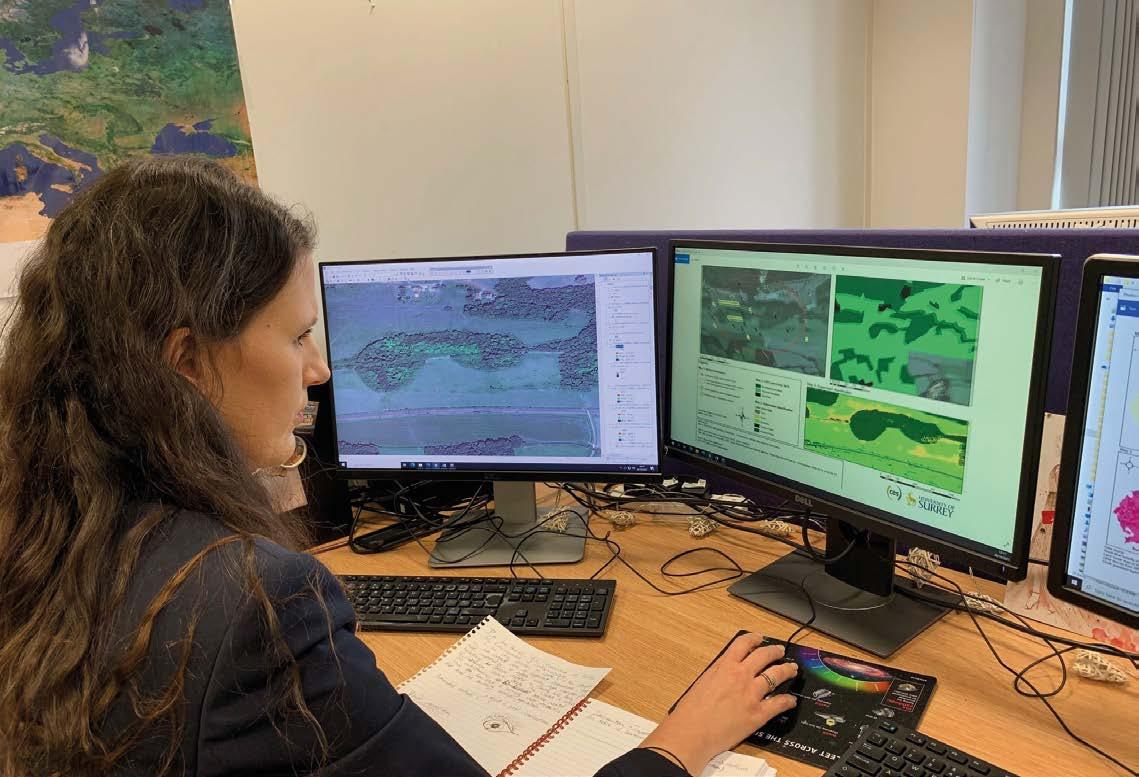
Benefits to species
Space4Nature will cover every kind of habitat in Surrey, from wetlands to woodland, from hedges to heathland. For example, even small and partially obscured clearings in woodland – which are important habitat for green hairstreak butterflies and the plants they depend on – can now be mapped and analysed. Our vision is of a network of varied and biodiverse habitats that support abundant wildlife – and every native Surrey species.
Farmers and landowners
Farmers and landowners play a crucial role in our efforts to recover nature; integrating habitat creation and restoration with food production and other land uses needs careful planning. Space4Nature will help us understand where minor improvements can contribute to the bigger picture, such as a line of restored hedging that could give dormice access to safety, feeding and breeding opportunities as part of several miles of connected hedgerows. Adjusting the mowing regime on some field margins could help a farmer complete B-lines that cross many properties, ensuring crops are pollinated for miles around. Space4Nature should also support the targeted use of emerging funding streams to help farmers improve their land for nature.
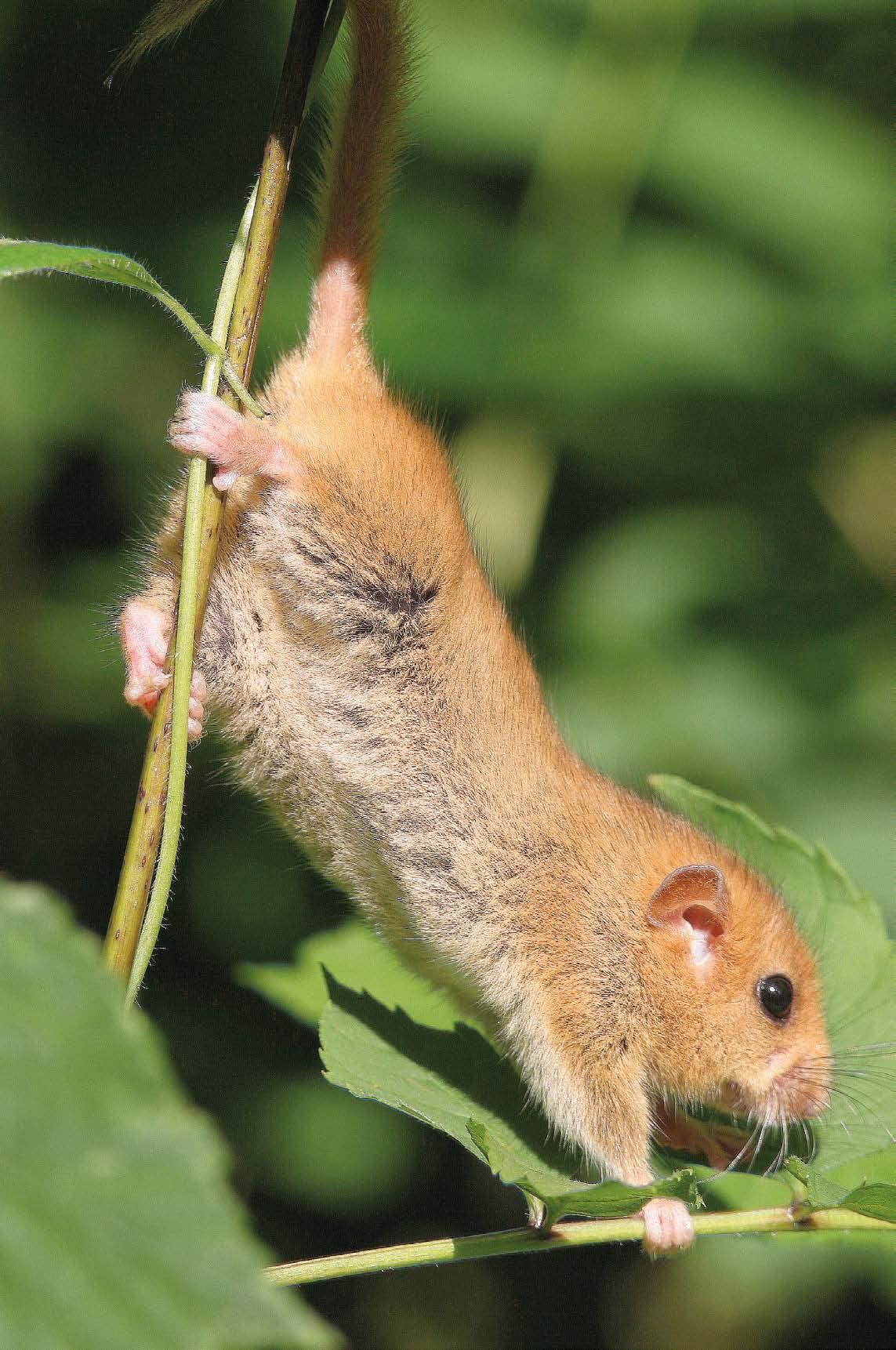
Progress so far
Since the announcement of the funding award from the People’s Postcode Lottery in the summer, the partners have been appointing staff and communicating with stakeholders. We’ll soon be moving into delivery phase: selecting up to six major test sites; recruiting and deploying volunteers; liaising with landowners; and identifying more potential locations.
You can help
Volunteers will be at the heart of this project, and we aim to engage some 1,500 people to help us monitor and record habitats and species.
Amphibians like this common toad need safe corridors to access breeding sites

© Jon Hawkins
Find
n To register as a volunteer visit surreywildlifetrust.org/space4nature
n See the national map of B-Lines at buglife.org.uk/our-work/b-lines/
n Discover Painshill Park at painshill.co.uk out more
Dr Ana Andries assessing satellite images of Surrey habitat © University of Surrey
Threatened mammals like this hazel dormouse will benefit from more interconnected hedgerow habitats
9 AUTUMN SCIENCE
© Ian Pratt
Scrubbing up for wildlife
Best-practice scrub removal demands expertise and sensitivity
James Herd, SWT director of reserves management
Scrub can be a vital habitat for many species and an important component in a diverse ecological community but, if left uncontrolled, it can quickly take over. We look at how SWT maintains the right balance on our reserves.
Scrub is the collective term for a range of woody vegetation that either tends to go unappreciated or is regarded as a nuisance. It encompasses young specimens of tree species such as silver birch, hawthorn and Scots pine, tall shrub species such as gorse, hawthorn and dogwood, plus garden escapees such as rhododendron and pyracanthas. You might describe it as the wildlife counterpart to garden weeds.
This is because if open ground is left to colonise, scrub will occur naturally. On lowland heath, for example, unmanaged silver birch scrub soon starts to encroach. Seed rain in autumn leads to an exponential increase in new plants, and soon the area reclaims its climax vegetation cover (usually woodland) in a natural
process called succession. Eventually the heathland habitat – and the species that depend on it – is lost.


Good scrub, bad scrub?
It is generally agreed that controlling scrub is important, as its dominance tends to suppress more delicate flora and constrain biodiversity. Having fewer plant species in the food web supports a less diverse assemblage of invertebrates, birds and other animals. However, while a gardener may aspire to a ‘flawless’ flowerbed, our priorities are different. Biodiversity demands a mosaic of habitats, so we encourage pioneer communities of native species, alongside bare ground, mature vegetation and more. Managing this mosaic requires expertise and sensitivity.
Benefits
It’s true that, like other plants, scrub sequesters carbon and could add to a more climate resilient landscape. Trees and bushes can also provide underground hibernacula for reptiles, which find spaces in the gaps between roots and soil. In summer, they create perches for songbirds, shady pockets of cooler microclimate, and wind shelter for butterflies and moths. Scrub also includes food plants for hundreds of invertebrates, including butterflies, moths, leafhoppers and shield bugs. However, excessive scrub in contiguous blocks not only reduces biodiversity but also increases the severity of wildfires. The situation is delicate and complex.
Management techniques
Conservation grazing is an excellent option. Cattle will browse scrub, but not control it as 90% of their diet is grass, however red deer are highly effective. In autumn the males bash trees and bushes while cleaning the velvet from their antlers. They also browse new shoots, shortening their
10
AUTUMN LAND MANAGEMENT
length and slowing growth. This causes gorse, for example, to grow in a more compact fashion, creating a more insulated structure that can be a lifesaving refuge for overwintering birds such as the Dartford warbler, which in the UK exists as a nonmigrant at the northern edge of its climatic range.
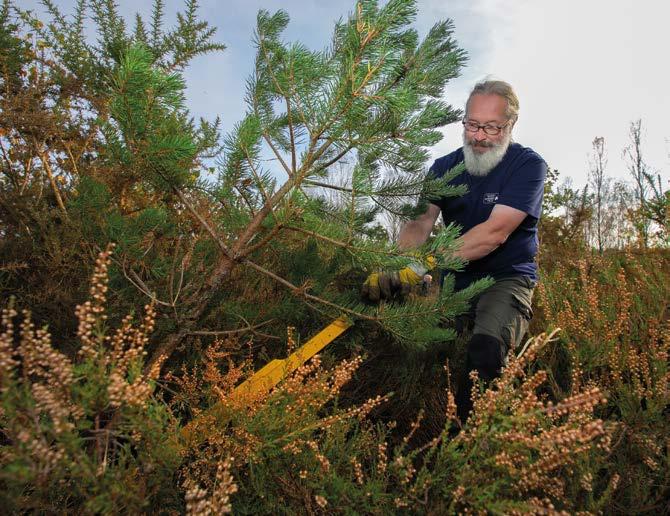
Outside the bird nesting season, we also rely on volunteers, who understand the characteristics of a site and predominantly use hand tools, such as loppers, bow saws and tree poppers. They work precisely, avoiding damage to anthills and other natural structures and can clear single stands of saplings where required. However, contractors with heavy equipment are vital too, especially in difficult conditions, where access is tricky, and on large-scale projects.

The key is applying knowledge and skill to a range of tasks, according to the needs of a specific site. A considered approach to scrub management can play a huge part in maintaining precious habitats.
CASE STUDY
Coneyboro Hill
Alongside neighbouring Fames Rough, this 6.6 hectare reserve is part of the Chipstead Downs Site of Special Scientific Interest (SSSI).
Until recently Coneyboro Hill had been neglected. Dogwood and hawthorn had colonised it and the important chalk grassland habitat was at risk. Following a visit from Natural England (NE), we planned an extensive scrub clearance programme.
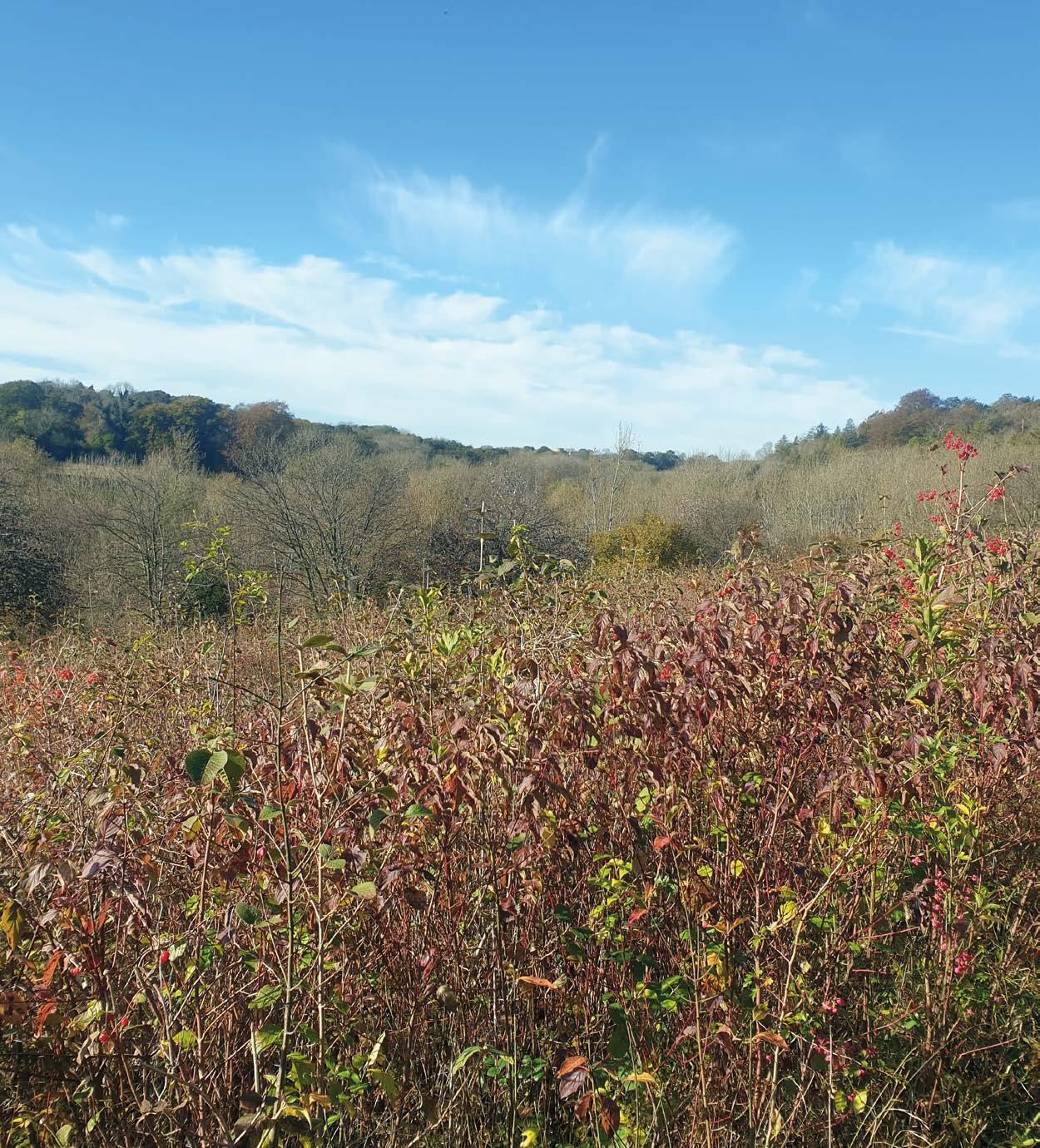
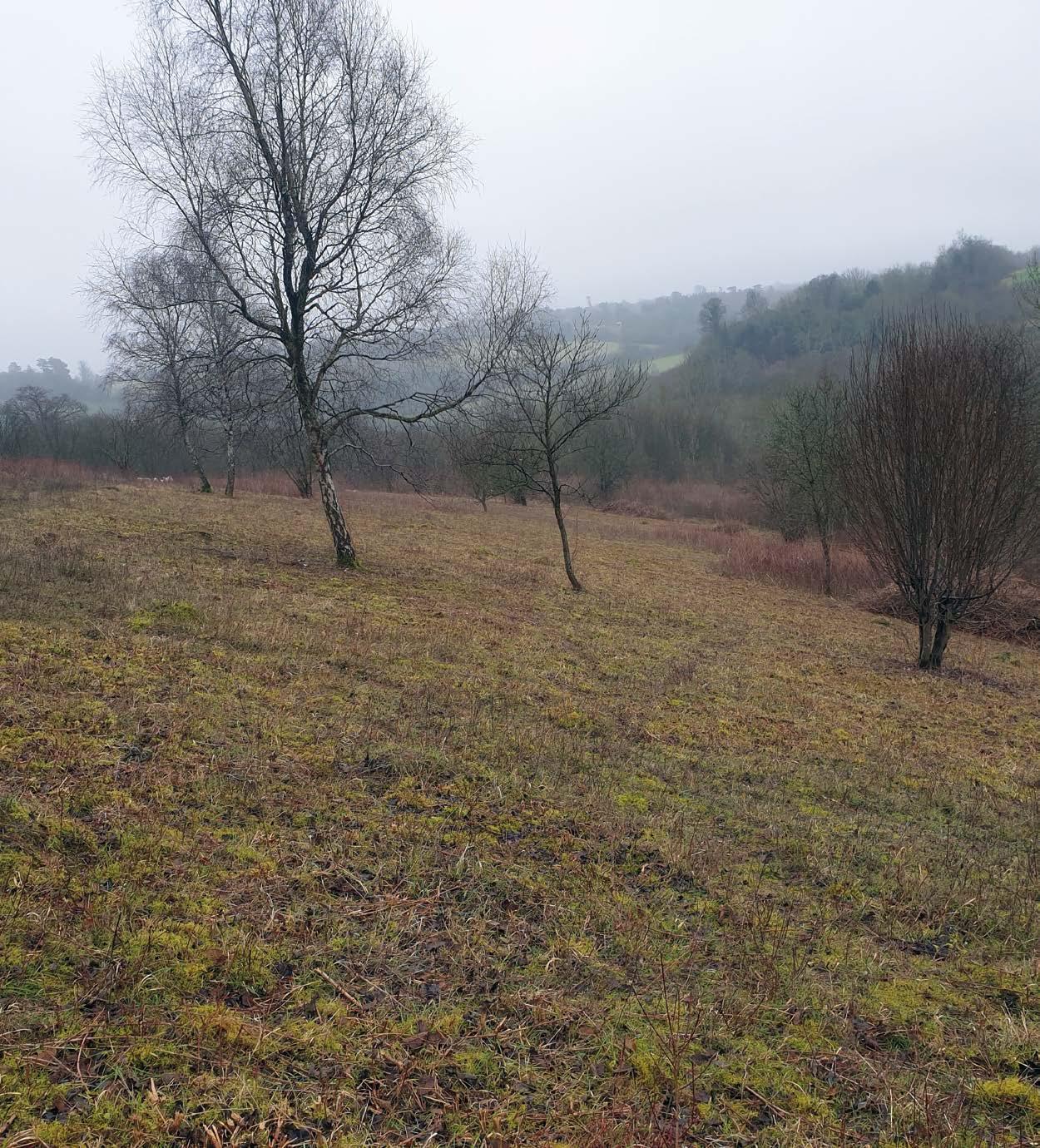
It wouldn’t have been possible to pile up the arisings on site and let them rot, so we built metal platforms where we could burn them in situ without damaging the chalk grassland. This was part of a painstaking process that also included bagging the ash, moving it

by wheelbarrow and transporting it off-site for appropriate disposal.
The immense effort was led by SWT’s Stuart Fleming and Eleanor Evetts, along with specialist contractors, members of the Surrey branch of Butterfly Conservation, and the WoodChips, a group of local conservation volunteers. Together we have spent more than 850 hours giving chalk grassland species a new opportunity to thrive.
The scrub is now more than halfcleared, and sheep and goats from the Downland Project are browsing the new vegetation as it grows. We look forward to monitoring how the wildlife responds over the next few years.
11
AUTUMN LAND MANAGEMENT
A fire platform for burning the arisings on site.
BEFORE AFTER
DADDY’S HOME
Sometimes under-appreciated, craneflies may be about to get some deserved attention.
 Mike Waite, SWT director of research and monitoring
Mike Waite, SWT director of research and monitoring
AUTUMN SPECIES FOCUS 12
White-legged cranefly © Mike Waite
Sprites and giants
I’m sure by now you will have been ‘visited’ by those light-attracted, dangle-legged autumnal sprites we’ve all grown up familiarising collectively as “daddy long-legs”, especially as the nights start to properly draw in. This name is undoubtedly applied in the vast number of cases to the September and common craneflies
Tipula paludosa and T. oleracea, which peak in adulthood at lateSeptember through October. Although still commonplace, the abundance of these creatures has noticeably declined over my lifetime, along with many other forms of formerly ubiquitous insect life. This will be bad news for birds like starlings that are seasonally prey-dependent on the pupae and larvae of the commoner species, known to gardeners and farmers alike as ‘leatherjackets’. The craneflies, or Tipulids, are one of the largest families in the order Diptera or ‘true’ flies. In fact, it is a cranefly that is the largest fly in the UK: Tipula maxima, or the giant cranefly, being a most impressive beast with a leg span of 10 centimetres.
Dampness required
There are around 330 British species of cranefly, depending on how you define them, with up to 250 recorded in Surrey. These include both the longand short-palped, the hairy-eyed and the fold-winged cranefly groups. They occupy a diverse range of habitats, but all rely on some degree of dampness to fully complete their lifecycles, even those of drier fields and meadows.

The truly wetland species lay their eggs in damp, rotting woody material and rich assemblages of species are often found in ancient wet woodlands or ‘carr’, dominated by alder and willow trees. Other types of woodland support species whose larvae develop in knot-holes of mature and veteran trees where rainwater pools for longest, such as the beautiful Ctenophora flaveolata, an admirable wasp-mimic (see above).
Indicators and recyclers
Craneflies can be useful indicators of the quality of their habitat, especially the purity of its groundwater, but also its complexity and ability to regenerate. They are also important drivers of the soil-cycling system, as they break down vegetable matter and return the nutrients to the soil; in woodlands the larvae work as detrivores, helping in the decay of dead wood in a similar way.
Important habitats
SWT manages at least two reserves recognised as particularly important for their craneflies: Bay Pond at Godstone and around Boldermere at Ockham Common. Here, many nationally rare and scarce species have at one time been recorded, including the UK endemic southern yellow splinter Lipsothrix nervosa, the spectacular giant sabre comb-horn Tanyptera atrata and Tipula livida, a Surrey and Kent wet woodland specialist. Another site along the River Wey at Eashing, close to where we have recently taken up management responsibilities for a new Suitable Alternative Natural
Greenspace (SANG), is also significant for its cranefly fauna.
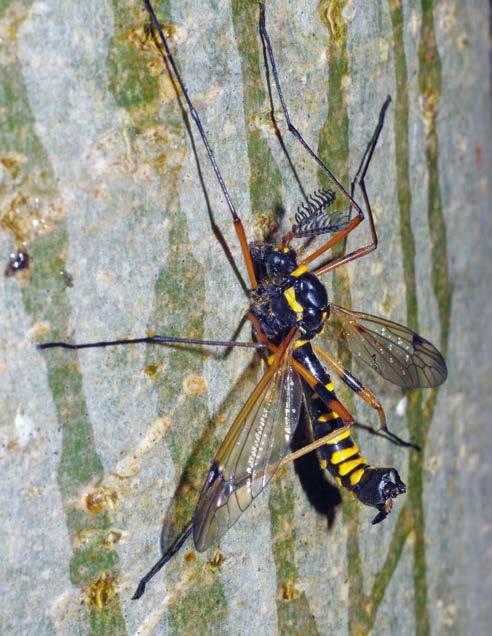
Collaboration opportunity
The trouble is, as an original ‘notified feature’ of their respective SSSIs in the 1980s, this cranefly interest has never been systematically updated or even recently verified and is therefore now a high research priority if we are to adequately accommodate the needs of the most-deserving species of the assemblage in our future management planning. This is partly due to the lack of skilled entomological expertise available for the required survey work, and simply to the group’s general lack of appeal to amateur naturalistrecorders. We have flagged this as an opportunity for academic collaboration with any would-be entomologists in our new edition of the Trust’s Research Prospectus 2022-23, which is available online now.
That being said, a new field guide by Alan Stubbs published last year – ‘British Craneflies’1 – could start to change this state of comparative neglect and will at least make craneflies more identifiable by virtue of its accessible taxonomic keys to all the known UK species. Hopefully a renaissance in cranefly recording is about to begin.
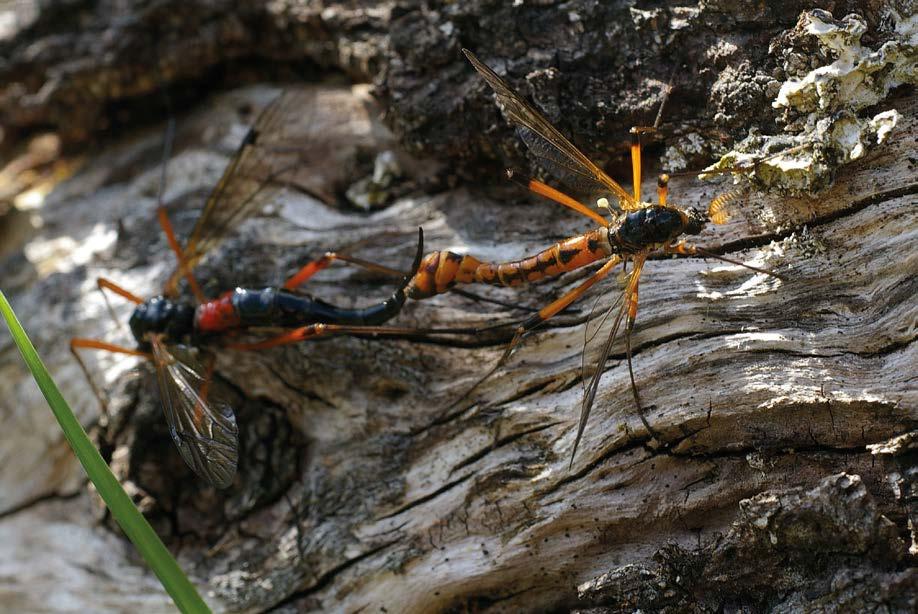
You can download SWT’s research prospectus at surreywildlfetrust. org/research-andmonitoring
1 Stubbs, Alan E. (2021). British Craneflies. BENHS
Common cranefly © Mike Waite
Giant sabre comb-horn (note sexes differ strongly in this species)
© Mike Waite
AUTUMN SPECIES FOCUS 13
Wasp comb-horn © Mike Waite
Nature needs people like you

Here we recognise the contributions of four of our amazing volunteers.
Simon Humphreys Volunteer site manager

“In 1982 I was working as a virologist at Beecham Pharmaceuticals, whose laboratory and grounds at Walton Oaks near Tadworth included Dawcombe nature reserve. For years scrub had been encroaching on the chalk grassland, so five of us set up a conservation group as part of the company sports and social club. Under a management agreement with SWT, we formed a working party and got started.
“Gradually other volunteers joined, and for 20 years we worked to enlarge and join up the grassland areas. In 2000 I finally persuaded Pfizer (who by then owned Dawcombe) to transfer it to SWT. A few years later, thanks to a donation from a volunteer, we bought the 30 acres of Fraser Down across the road.
“You could say the first scrub clearance was the easy bit. The seed bank underneath it is so well established that now we continually have to keep new seedlings under control. I strongly believe that you should only clear what you have the resources to maintain. Otherwise, you just go around in circles.
“As part of this management effort, we wanted to introduce cattle for conservation grazing.
This required water, but on such an inaccessible site, surrounded by SSSIs, there was no mains supply. I used my design and practical skills to draw up plans for a rainwater harvesting system. I then had to raise money to pay for materials and installation, making it vandal-proof and ensuring we collected enough water at the right time of year to last through the summer.
“We have consistently had working parties two Sundays a month and sometimes more often. The core group is about 40-strong, some of whom have been together for 20 years, and it’s always lovely to welcome new people. We also work closely with local parish councils and other landowners.
“We constantly see the impact of our work. For example, this summer we had experts trapping moths on both reserves. They identified more than 650 species, some of which are real rarities.
“I must enjoy it because I’m still here after 40 years. There have been some frustrations along the way, but it’s deeply satisfying to know the land is now well looked after and that our volunteers are getting pleasure from it, gaining experience and learning new skills.
Because of the sensitivity of their wildlife, both Dawcombe and Fraser Down reserves are closed to the public, although Simon occasionally leads walks for local wildlife groups.
Volunteers are the lifeblood of Surrey Wildlife Trust. Whether you can spare a few hours or make a long-term commitment, you can make a huge difference for nature and people.
I commit about 100 days a year to the reserves, doing something or other almost every day. Over 40 years that adds up to quite a lot of time.
14 AUTUMN VOLUNTEERS
Zygie Hayes
Cattle lookerer
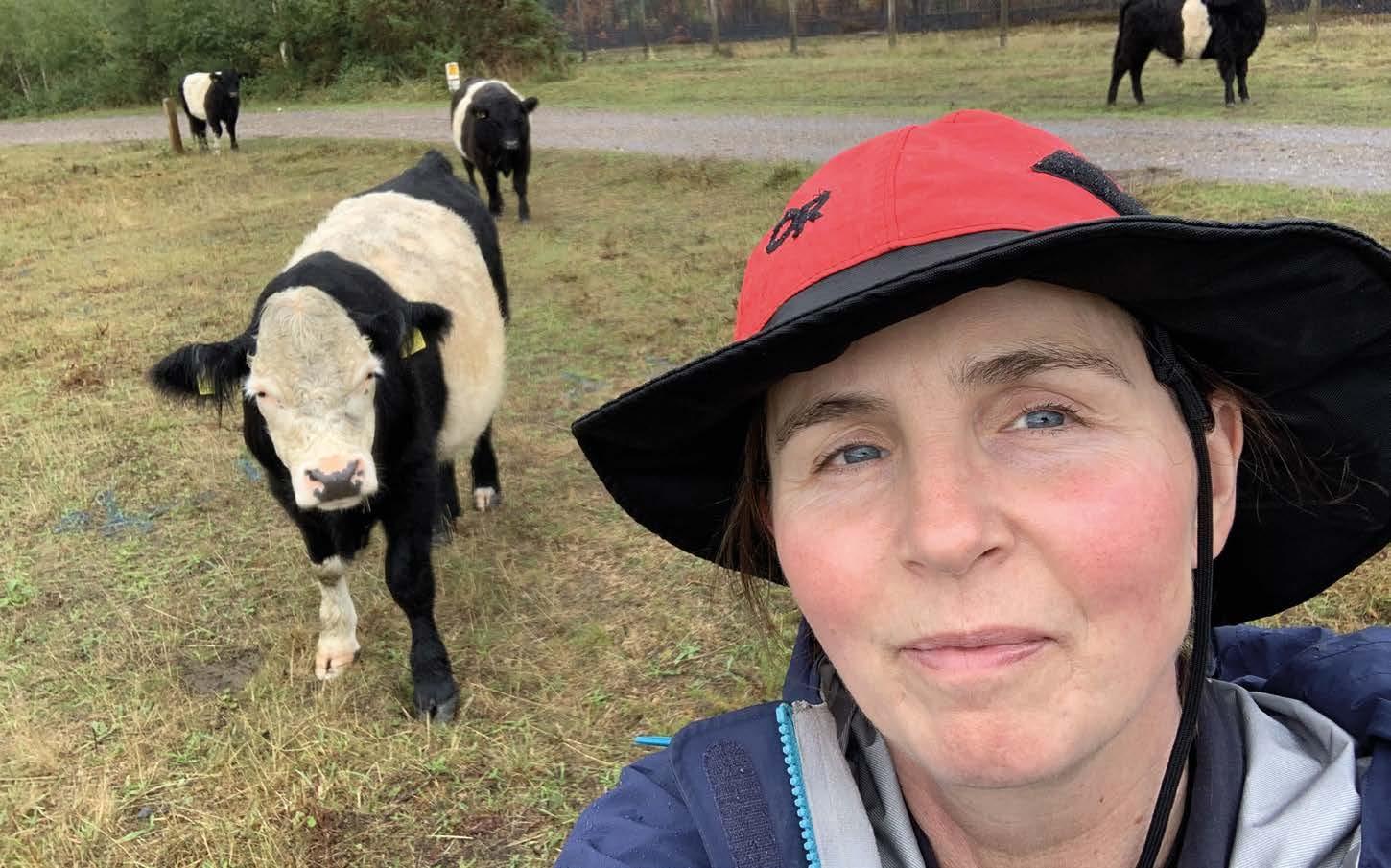
“I’ve been a member for ages and got more involved when I won an SWT wildlife gardening award a few years ago. I started volunteering, clearing scrub and so on, but six years ago the Trust started grazing cattle on Folly Bog, which is next to my house. I decided to become a lookerer –someone who keeps an eye on livestock.
“We have ten male Belted Galloways on the reserve at the moment. I check them every Friday and often at the weekend, and other people do other days. Sometimes they are very good and wait at the fence for me, but sometimes they can be amazingly hard to find. You would think a tree or shrub wasn’t big enough, but there’s a group of cows behind it.
“Once I’ve tracked them down, I look them over for lumps, sores and injuries. Checking their hooves are healthy in the middle of a bog can be interesting.
If there are any issues, I phone them in to the SWT grazing team.

“I also make sure there are no problems on the reserve itself. The other day we found a gate that was on the verge of falling apart, so my husband and I did some repairs.
“I have had the odd minor escape, when one of the Belties jumps the cattle grid and the others want to follow. Once I had to accost a runner to help me persuade the stray back through the gate.
Don Potts Volunteer warden
“In 1979 George Blaker, who owned Vann Lake, invited me to come and live in a cottage on the reserve. I had trained as a plant biologist and taught for a couple of years, then worked for the British Trust for Conservation Volunteers.

“I used to monitor the birds, plants and fish, and I regularly heard otters when they came up the River Arun to feed on eels in the lake. Vann Lake was also believed to have the best assemblage of fungi in the UK and we regularly had visits from university departments to catalogue the various species. Maybe this was connected to our non-intervention policy: if a tree fell, we left it alone.
“I was soon asked to be chairman of SWT and saw many changes, including its name, structure, staffing and fundraising. This included the £70,000 we needed to buy Vann Lake. Later I became national director of The Wildlife Trusts, running the London office. I worked closely with David Attenborough to raise money and buy nature reserves around the country.”
I became the volunteer warden at Vann Lake and have maintained my interest in it ever since. It was a fascinating place to live – and only a short walk to the cricket pitch!
In a way it reminds me of times gone by. I have owned horses and was brought up close to dairy herds, so it feels like going back to my own little bit of farming.
15 AUTUMN VOLUNTEERS
© Lorraine Potts
Viv Sidlin
Education volunteer
“I became a volunteer six years ago after I stopped working and had more free time. I started by helping on conservation work parties, but as soon as I visited Nower Wood and met Louise Shorthose (SWT outdoor learning manager), I was hooked on the idea of education. I’m not a scientist, but I wanted to share my enthusiasm for nature.

“It was fascinating from day one. I started by shadowing school visits and I learned so much. I could feel my confidence steadily growing and after a while I was able to lead groups (and even find my way around the woods in any season).
“The education team are often working offsite on the Wilder Schools project, so there are more selfguided and volunteer-led sessions at Nower Wood. We cover a range of activities, from minibeasts and ponddipping to species identification.
“It’s enjoyable and challenging, I feel valued and appreciated by the SWT team, and I get huge benefits in terms of wellbeing.
“One of the highlights so far was the summer sessions we did with special needs children. The excitement was palpable – and they got so much out of it.”
Volunteer opportunities
Thank you to all our volunteers for their huge contribution to our work. If you would like to join them visit surreywildlifetrust.org/volunteer

16 AUTUMN VOLUNTEERS
“I love sharing the children’s excitement at being outside – they seem to naturally embrace the woodland. I’m still learning too – some of the children come with so much knowledge. We also host visits from NHS staff, families and other adults."
Create your own
Wilder Community
Neighbours come together to combat climate and nature crises
Community groups across the county are learning how to take local action for nature thanks to a series of webinars designed to encourage Surrey residents to work together to bring nature closer to home.

By sharing knowledge and examples from residents’ associations, parish councils and other groups, the webinars will show how simple actions can help create a joined-up network of habitats to enable wildlife and people to flourish.

From a community wildflower garden to a restored pond, from a revitalised river to newly planted native trees in a playground, biodiverse environments bring health, mental health and economic benefits. They also contribute vital services such as flood prevention, pollination and carbon storage.
Claire Harris, SWT community engagement manager, says: “At Surrey Wildlife Trust we are working extremely hard to ensure wildlife is protected, but
we cannot do it alone. If we are to help our wildlife to survive, the answer must come from within the local community – it needs to involve everybody, everywhere. Our job as Surrey Wildlife Trust is to bring people together and provide the connections and the inspiration people need to get started”.
One of the first webinars featured an inspiring talk about the power of volunteering from Keith Lightfoot of the Unstead Nature Community Group, which manages the 25-acre Unstead Nature Reserve near Godalming (see Surrey Nature autumn 2021 issue for details).
Other sessions included SWT CEO Sarah Jane Chimbwandira discussing how connecting fragmented habitats will be key to tackling the biodiversity crisis, and Bryony Carter from The Wildlife Trusts talking about the central role that people from all communities can play.
The next ‘Action for Nature’ webinars
will take place on 9 November and 1 December. Alongside sessions on the importance of ponds, hedgerows and wildflower meadows, SWT trustee Chris Howard will explain how she has worked as part of the local community in Wonersh and Shamley Green over the past three years to develop two thriving village environment groups, each with its own biodiversity action plan and website. Chris’s experience in local government has been vital in getting these projects off the ground.
As Chris says: “It is one thing to decide to plant some trees, but it is quite another to secure sign off from councils, carry out consultation with residents and agree which trees go where and how they will be looked after in the first few vulnerable years. However, it is more than worth it.”
There will also be a further event in January, followed by two workshops in spring 2023 and a community conference in the summer.
‘Community wildlife gardens bring people together and improve the environment for everyone’
Find out more and sign up for these free events at: surreywildlifetrust.org
© Adobe / Pellinni
17 AUTUMN COMMUNITY
© 2020VISION
Members rally for Pirbright Ranges
Wildfire appeal raises over £43,000
Major wildfires this summer have put Surrey on the front line of the climate and nature emergency.
Outbreaks on Hankley and Chobham Commons and Ash Ranges showed how our internationally significant heathland is vulnerable to hotter, drier conditions. In August, following a massive outbreak on Pirbright Ranges, SWT launched an emergency appeal for donations to help restore this most precious of heathland habitats and support the 200 red deer that help maintain it. Thanks to the generosity of over 850 supporters across the county, by September the appeal had generated over £43,000.
Rare species perish

Pirbright Ranges is one of the largest areas of lowland heath in Surrey and home to many rare and threatened species. Patches of ground continued to burn even five weeks later, and more than 650 hectares of pristine heathland were severely affected. Hundreds of rare ground-nesting bird chicks that were too young to fly away from the fire, including European nightjars, Dartford warblers and woodlarks, will have perished. The damage will also have prevented their parents from nesting a second time this year. Reptiles such as slow worms, grass snakes and adders have also died, alongside invertebrate species including endangered heath tiger beetles and silver-studded blue butterflies.
Deer at work
Pirbright Ranges is owned by the Ministry of Defence and is inaccessible to the public but is managed for wildlife by SWT. We keep a herd of red deer on the site to graze the heathland, which reduces the dominance of scrub, including Scots pine, common gorse and silver birch. This allows slower-growing dwarf scrub and specialist heathland plant communities to flourish and create the foundation of the unique heathland ecosystem.
Deep impact
The fire has potentially burned deep into the ground, affecting plant species including round-leaved sundew, marsh clubmoss and bell heather over hundreds of hectares. While the heathland will regenerate over time, it is likely to be eight to twelve years before it returns to full health.
The deer will perform a unique role in ensuring the heathland habitats recover during this time.
Protecting the herd
However, the deer themselves have also been affected by the fire: hundreds of metres of fencing that keeps them safe now need to be replaced; the animals have received vet checks and inspections by SWT staff; and the forage they rely on through the winter has been reduced, so we will provide supplementary food in the form of haylage. Happily, the success of our appeal means that we can fund this additional investment without compromising other planned activity.
18 AUTUMN WILDFIRE APPEAL
Below: Slow-worms – sad casualties of the fire on Pirbright Ranges
Priceless habitat
Given that around 85% of heathland in the UK has been lost over the past 150 years through agriculture, urban development and changes in land management, we cannot afford to lose more of it. SWT manages several areas of heathland, including Chobham
Common National Nature Reserve and Wisley and Ockham Commons that are particularly susceptible to fire in
dry conditions – which will lead to a severe strain on resources in the years ahead. Managing this unique habitat already costs hundreds of thousands of pounds a year and dealing with the impact of the Pirbright Ranges fire is expected to account for more than 30 additional days of SWT staff time this year alone.

You can still contribute to the welfare of Surrey’s precious heathland.
By making a donation you help us both preserve an important historic landscape and secure the future of many specialist species. If you have donated already, THANK YOU!
For more information visit surreywildlifetrust.org/ support-us/make-donation
Prevent wildfires
Help us protect Surrey’s wild places from the threat of wildfire. When you’re out in the country, please:
Extinguish cigarettes properly. Never throw cigarette ends onto the ground or out of car windows.
Take your litter home. Glass bottles or reflective metals can start fires.
Don’t have open fires or barbecues.
Burnt heathland at Ash Ranges
19 AUTUMN WILDFIRE APPEAL
In this new series SWT staff and stakeholders will offer a personal insight into a wildlife-related topic.
GAMING FOR NATURE
Since I first became attached to my GameBoy and obsessed over catching Pokémon, I have loved gaming. However, I also grew up loving nature and, despite what the media and people around me were saying, never felt my two passions were irreconcilable.
I didn’t want my nature-loving friends and colleagues to judge me if I spoke about the latest thing I’d been playing, or the new game I was looking forward to. However, this was the way people seemed to refer to the new generation of children –that gaming was a technological evil of the modern era, disconnecting them from nature and distracting them from the real world. Surely it was even worse for someone working in conservation.
However, over the years I have become increasingly convinced that I was right.
Unexpected knowledge
The first indication of this was when I started working at SWT’s Nower Wood Educational Nature Reserve, where I quickly became familiar with what children were interested in (spoiler alert: it’s still Pokémon). We ran sessions for local school students, teaching them about everything from trees and invertebrates to woodland management, and one curious thing kept happening: they came to the woods already knowing about silver birch trees and how charcoal is made. I soon discovered why. It wasn’t because of school or trips to nature reserves with their parents. It was because they’d seen it on Minecraft.
Personal view
Always treating screen time as the enemy means we miss an opportunity to engage children with the natural world.
Ben Siggery, SWT GIS, research and monitoring manager
AUTUMN PERSONAL VIEW 20
Which path to take?
There are two ways to respond to this. One is to roll your eyes and think, “Of course, that’s the only thing they pay attention to – they need to get off their computers and go outside.” The other is to see it as a fantastic opportunity to work with the gaming industry to promote nature and educate players.
Artistic tradition
The natural world has always been a source of inspiration for art – paintings, sculptures and music throughout history have tried to capture the beauty and intricacy of nature and the environment. Gaming really isn’t anything new in that regard. Whether it’s the detailed recreation of forest or coral reef environments for players to traverse or the animation of fanciful creatures based quite clearly on their real-life counterparts, there is an inescapable link between what’s on our screens with what’s outside.
Immersion and imagination
Sure, I learnt about insect metamorphosis from the Very Hungry Caterpillar. But also from Pokémon, where I saw my Caterpie grow into a Butterfree* and was introduced to the adaptations, behaviours, habitats, and natural predators of very real lepidopterans. A study by Exeter University in 2021 showed exactly this: gamers who had played Red Dead Redemption 2 were better able to identify animals featured in the game and understood many of their typical behaviours. Like the children at Nower Wood, they weren’t being educated in any traditional way, but immersed in a medium that had captured their imagination. They were learning without realising it.
Environmental messages
Beyond any accidental learning and exposure to nature, gaming also has the potential to help shape and inform environmental attitudes.
Several recent mainstream titles, such as Animal Crossing: New Horizons, promote pro-environmental behaviours including recycling and planting flowers to attract insects. There is also a growing library of indie** titles such as Alba: A Wildlife Adventure, where you play as a young girl who loves bird watching and is fighting to stop a hotel development on her local nature reserve. The gaming industry is coming onside and conservationists must be there to support it.
Pros and cons
It is an inescapable fact that we are surrounded by and dependent on technology in our personal and professional lives. This has undeniably improved the quality of the human experience in many ways, especially during the pandemic. And it’s changing the way we study and protect the environment, exemplified by the upcoming Space 4 Nature project that SWT is involved in. Studies have even shown how games and virtual experiences can recreate the wellbeing benefits of physically being in natural spaces. And let’s not forget that IT skills and an understanding of data management, problem-solving and design software are now vital to many careers in conservation.
I’m certainly not trying to claim there are no negative impacts from our dependence on our phones and computers; rather that we should embrace technology for the learning opportunities it offers us and future generations.
*Caterpie is a caterpillar-like creature heavily based on the Eastern Swallowtail caterpillar, it evolves into a cocoon (Metapod) before becoming an adult butterfly (Butterfree).
** An indie (or independent) game is a video game typically created by individuals or smaller development teams without the financial and technical support of a large publisher.
Minecraft – a sandbox game giving players complete freedom to explore the world and gather materials to build and craft.
Pokemon – a cultural phenomenon from Japan based around the concept of collecting creatures that are often based on real animals and plants.
Red Dead Redemption 2 –an open-world game set in the American Old West where players can hunt animals and collect plants as they explore the landscape.
Animal Crossing: New Horizons – a game where players look after an island and its anthropomorphised animal inhabitants, doing activities such as growing plants and collecting insects.
Below: Eastern swallowtail caterpillar
 © Adobe / F_studio
© Adobe / F_studio
AUTUMN PERSONAL VIEW 21
A garden in balance
Delegate, delegate, delegate. The mantra of effective leaders
By Lucy Cahill
Slug defence
If you spend a lot of time fighting slugs, you can encourage their predators, such as hedgehogs and toads, by leaving undisturbed corners where you pile up the autumn leaves. Cut a small hole (about the size of a CD case) at the base of your fence to let hedgehogs come and go. Make a log pile and prop up an overturned flowerpot in a damp and shady spot where toads can hunker down.
Easier weeding
If weeding seems an endless task, you could add ground cover to your beds, which will foster its own ecosystem. In shadier spots, bugle or sweet woodruff will spread unaided, but both are easily kept in check. For sunny areas consider creeping thyme, Aubrieta, Stachys (lamb’s ear) or a personal favourite, moss Phlox
One good turn...
Support garden wildlife this autumn and it will help you in the future. Put up nestboxes to encourage birds to gobble up caterpillars; plant climbers to turn a sterile wall into a bountiful habitat; dig a pond to encourage amphibians to move in and start a
Anti-aphid
If aphids are your nemesis, key predators include ladybirds and hoverfly larvae. You can help ladybirds to thrive by providing places for them to overwinter (leave hollow stems standing until early spring), and you can support hoverfly populations by providing nectar-rich umbellifers, such as fennel and wild carrot, and other open flowers, such as apple blossom, knapweed, and myrtle.
Free plant food
If feeding your plants is a high priority, repurpose your kitchen and garden waste into compost. A one square-metre compost heap can house and feed huge numbers of invertebrates, as well as more unusual residents such as grass snakes and slow worms. You may be able to layer the compost on your beds as a mulch (ideally in late autumn), protecting the soil and leaching goodness into next year’s crops.
Grow you own… trees!
Protecting saplings that have successfully germinated after being planted by squirrels, jays or the wind is often the best way to create new woodland. Or you could try being a jay this autumn and plant your own acorns. Collect seeds that look healthy (if they float in water, they’re too dry). Plant them in a pot and keep the soil a little damp, watering from a tray below. You can also try sweet chestnuts, conkers, and hazelnuts. Seeds in fruit, such as rowan or hawthorn, can be squeezed out before planting.
Top tips:
n Use mesh to protect pots from mice and squirrels.
n Reuse containers rather than buying new.
n Mix compost with soil from where the tree will be planted to avoid waterlogging and allow roots to find their fungal friends.
n Plant seeds at the same depth as their width.
slug-patrol. Once you’ve done all this and your garden is teeming with life, you may find there’s an additional harvest – the enormous happiness of sharing your space with so many vibrant characters. Life is richer when nature is invited to the party!
n Many seeds need a good cold snap to help them break dormancy, so you don’t need to keep the pots warm.
n Check the Wildlife Trusts website when you are ready to plant out – the right tree in the right place is important.
applies equally to the garden. But it doesn’t require a brigade of human assistants. Rather, we can call on our own wild workforce to make life better for our native species.
22 AUTUMN GARDENING
Build your own hibernaculum
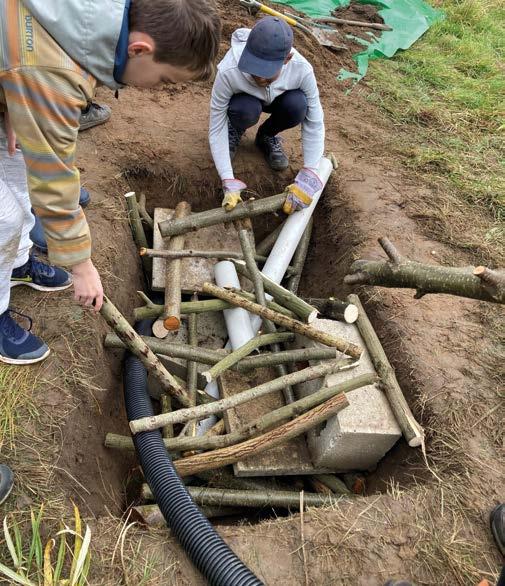
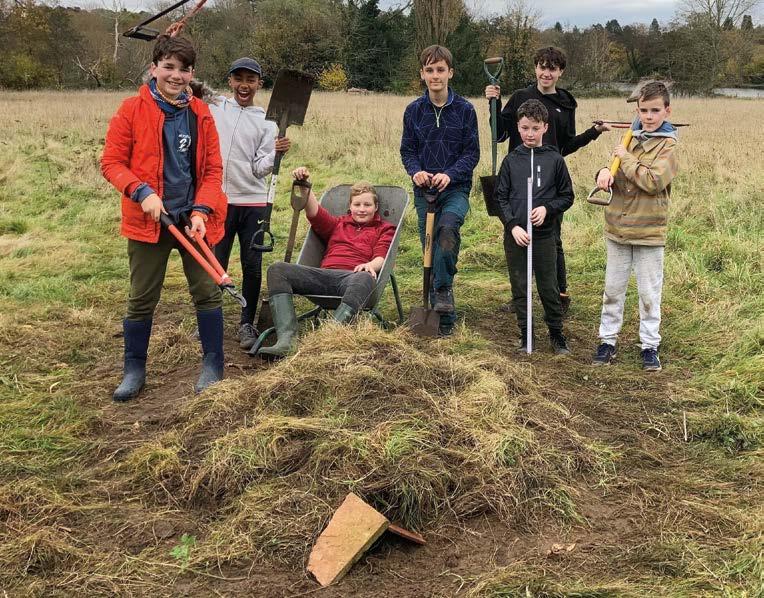


A hibernaculum (from the Latin for ‘winter quarters’) in your garden will provide a safe, cosy winter refuge for hibernating reptiles, amphibians and other wildlife. While most species will have already chosen their sites for this year, autumn is the perfect time to build a shelter for next winter.
1
Here’s our visual guide for making a hibernaculum, with thanks to Karl Florian, Sam Mugisha, Nathan Stevens, Owen Williams, Gabriel Berry, Samuel Newman and Fraser Byrne of 1st Whyteleafe Scouts, who gave their time to make one at Bay Pond. We expect this to be used by common frogs, common toads, grass snakes and smooth and palmate newts.
Remove and reserve the turf from an area of well-draining ground. Any size will do (ours is approximately 150cm x 75cm).
2 Dig a hole at least 60cm deep.
3
Lay pipes in the corners. Place a long stick or similar inside each one to help reptiles and amphibians to climb through.
4 Fill the rest of the hole with rubble to create nooks and crannies. Reptiles and amphibians can squeeze through very small holes.
5
Top with a thick layer of fallen leaves for insulation.
6 Re-lay the turf or cover with top soil and scatter wildflower seeds.
To encourage reptiles, place a sheet of corrugated metal in a nearby sunny spot. Craving warmth, they are sure to hide under it. A small wildlife pond will attract amphibians.
Save water
With water supplies increasingly under pressure, gardeners can take simple steps to help retain moisture during dry periods and create healthy habitats for wildlife. Start by using wastewater from the bath or sink to water plants, and also avoid unnecessary digging, which dries the soil. Water butts are an easy way to store rainfall that falls on house and shed roofs.
In the longer term:
n Use organic matter and mulch to help the soil retain moisture.
n Install a pond or bog area with plenty of native plants to give wildlife a place to live. Even if they dry out in summer, the mud provides a vital home for plants, amphibians and invertebrates that are important food sources for other wildlife.
n Reduce paved areas in the garden to allow water to soak into the ground rather than run off and increase the risk of flooding on roads.
23 AUTUMN GARDENING
The Wild Parent’s Pocket-kit
 By Lucy Cahill
By Lucy Cahill
“Take your toddlers outdoors!” they say, and so you strap on your carrier, hoist your little one in and head off to the woods.


You will breathe in the frosttinged air, soak up the golds and the russet-browns and watch the falling leaves spiralling… so mindful, so good for you both… and fabulous if your little one stays calm and content snuggled into your back as you stride purposefully through the crinkly autumn carpet.
This is not my reality. My little one is a wriggler, and the carrier lasts mere minutes before she needs to be down in the mud herself. And of course, it’s the best place for her to be – using all her senses and following her play instincts, in the biggest, best, FREE toy shop nature can offer.

AUTUMN CHILDREN 24
Pocket knife
The possibilities are endless, and when I forget mine I spend most of our time thinking of things we could have done if only we had it. Last week we made holly-whip crowns: Find a long whip of holly, cut it (carefully) from the tree, slough off all the leaves and twirl it around itself to form a circle, the size of your little one’s head. Little one’s job is to fetch fallen leaves and weave them into the crown.
2
String
When you need to make a stick man/ picture frame/mobile/fishing rod, you need your trusty ball of string.
1 4 5 5


A Sharpie
What is a stick man without a face?
Jumbo chalk
From doodling patterns on a stump to finding a face in the bark, making a sign for a den or leaving a decorated leaf on a wishing tree, jumbo chalk is your little one’s friend, and it will wash away in the rain (maybe brightening a passing walker’s day before it does).
A cuddly toy
So many adventures to be had – just pull out a (washable!) furry friend and see what your little one does with them.
There are a few things I take on all our walks, and I recommend that if you have a toddler or preschooler, you do too. A simple pocket-kit that will let your little ones make the most of all the play opportunities that abound in our woodlands. 3
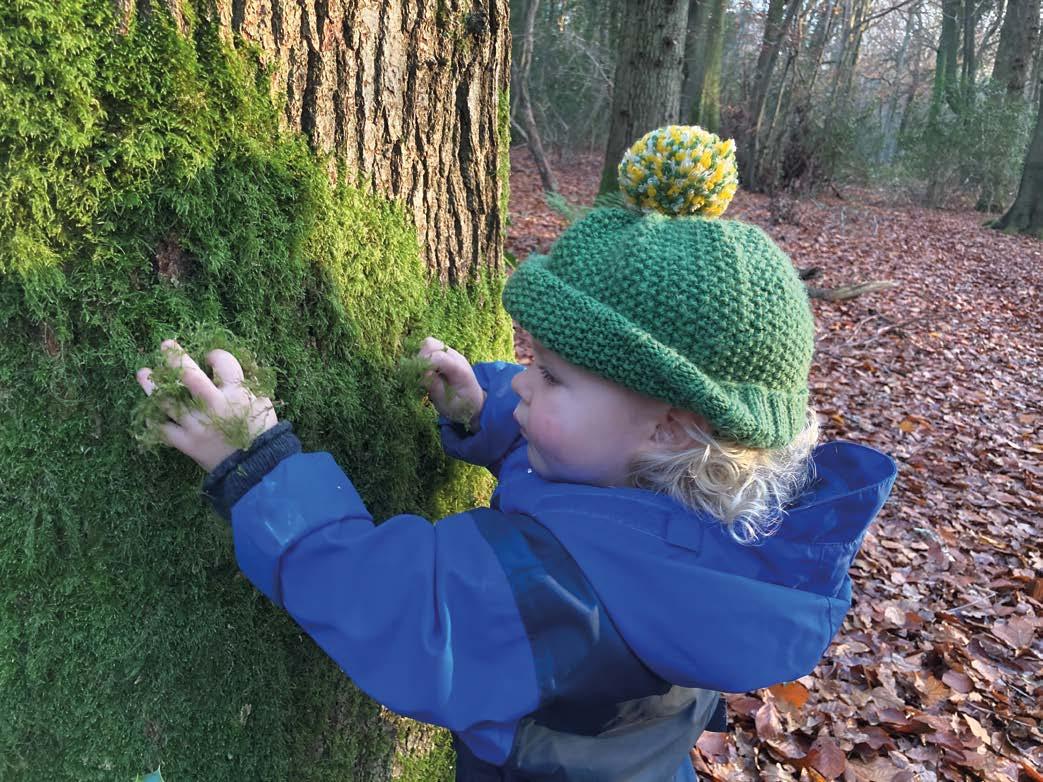

A book
When the time comes for a snack and a warm drink, a seasonal story makes the woods feel like home. Most recently we’ve been loving Ferdie and the Falling Leaves by Julia Rawlinson. Some other inspirational favourites include Not a Stick by Antoinette Portis and Leaf Man by Lois Ehlert.
And a word of advice: we are often conscientious about waterproofing our children so they can throw themselves into play without the discomfort of a soggy bum and knees. Remember your own waterproof trousers! You, and they, will have much more fun if you can be as carefree as they are.
Enjoy :-)
Images ©
25 AUTUMN CHILDREN
Lucy Cahill
Sadie Miller has joined Surrey Wildlife Trust as our new fundraising manager, after many years’ experience in the charity sector. She is looking forward to getting to know all our corporate supporters in the coming weeks. If you’re interested in contributing to our work, please contact her directly at sadie. miller@surreywt.org.uk
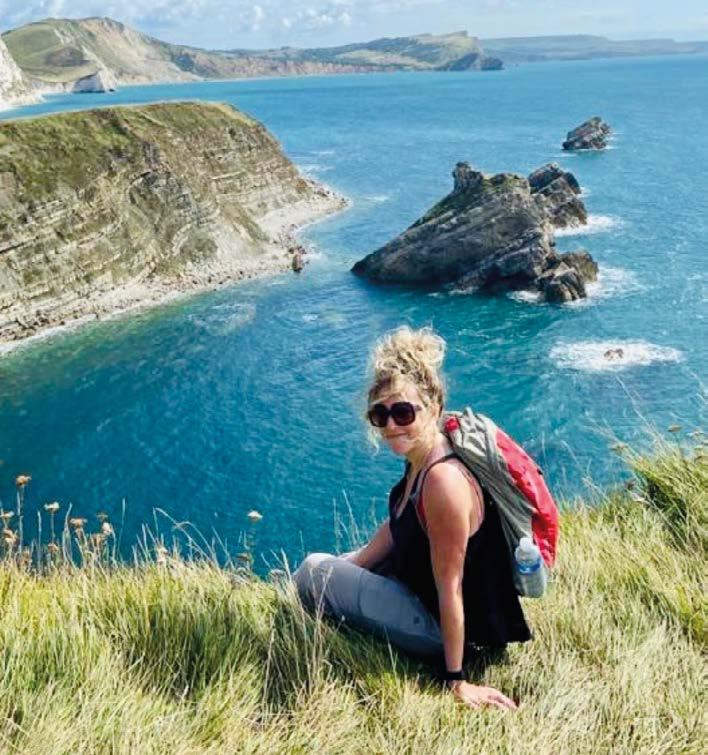
Art for wildlife
Many thanks to David Paynter at the Artful Gallery, who generously donated proceeds from this year’s Art & Soul exhibition to SWT and other local charities. theartfulgallery.co.uk
A big thank you to all our business supporters
Gold partners
Belron
Camberley Heath Golf Club
Chessington World of Adventures Resort
Jacobs
Kia UK
Mayer Brown
Molesey Veterinary Services
Premier Miton Investors
Priory Hospital (Woking)
Royal Wimbledon Golf Club
SES Water
STIHL
St George’s Hill Golf Club
Thakeham Homes
Toyota (GB)
UK Power Networks
West Hill Golf Club
Woking Golf Club
Silver partners
Affinity Water
Jenoptik
Mondi
Thames Water
Bronze partners
Clandon Wood Natural
Burial Reserve
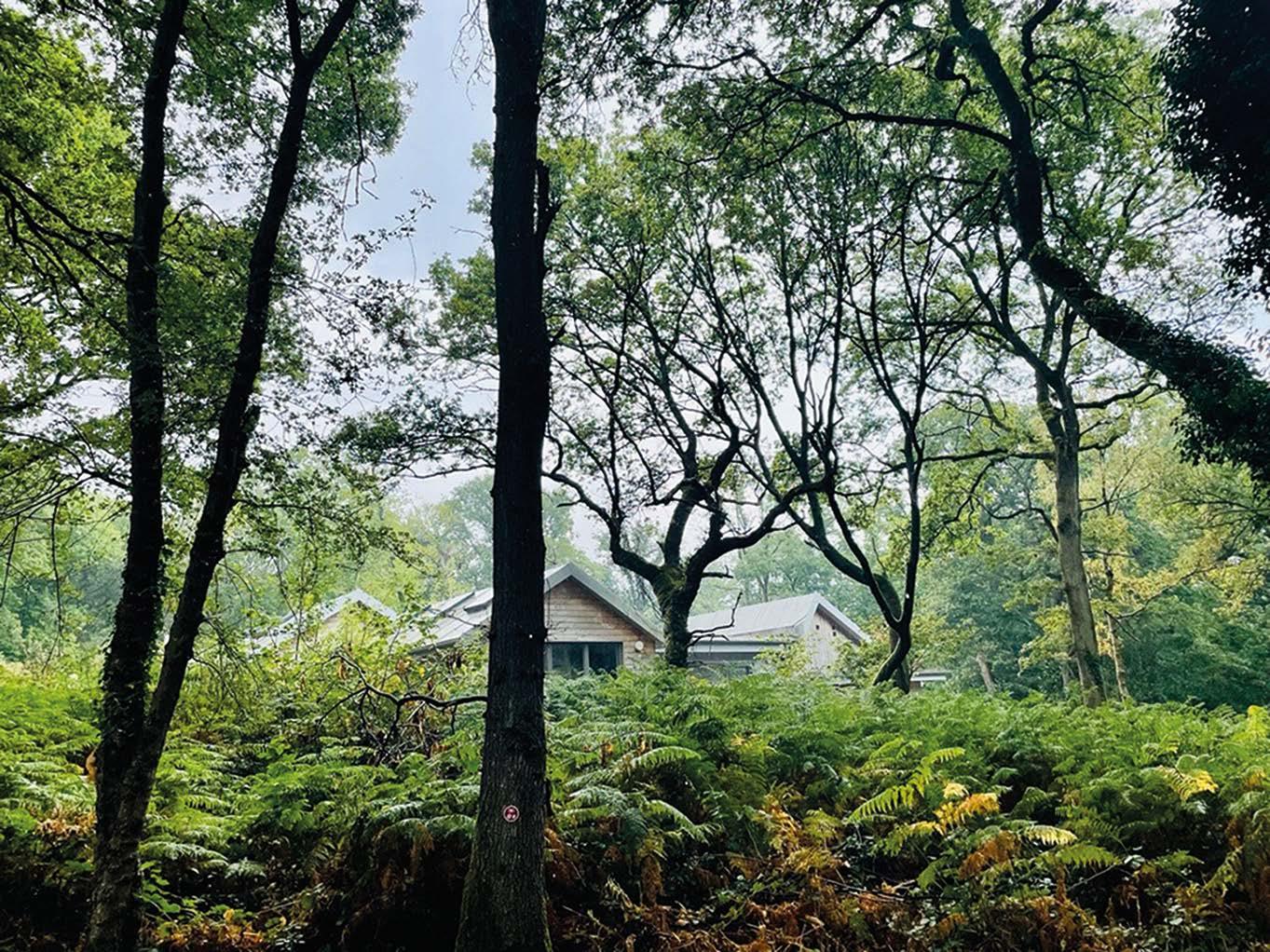
Effingham Golf Club
NDC Garage Doors
Novex Solutions
rhw Solicitors
Sibelco (Europe)
Walton Heath Golf Club
Wienerberger
Small business partners
The Albury Co
Alpha Vets (Teddington and Claygate)
Aubergine Legal
Avery & Brown
Broadband UK
CS Virtual Assistant
Forays Homes
Landscaping Solutions
Lending Expert
Mortgageable
Novex Solutions
Wild Learning
Charity of the year
Co-op
Business supporters and donors
Amazon Smile
Bell’s Whisky
Benevity
British Wildlife Centre
BUPA
Car Take Back
Chalford Property Co Ltd
Cotswold Outdoor Clothing
Hitachi Capital
Network Rail
Project Five
Surrey County Council
Surrey Hills Photography
Tesco
University of Surrey
Vine House Farm
Waitrose
26
Nower Wood, used by our corporate sponsors for meetings, nature-based activities and away days.
Welcome Sadie!
AUTUMN CORPORATE NEWS
INTRODUCING... Billie Pearce, community officer
How long have you been at SWT and what’s your role?
I’ve been here since July 2022, working on the Nextdoor Nature project. It’s a grassroots programme that helps communities create habitats in everyday local spaces, from playgrounds to pieces of neglected land. So far, I’ve been designing the programme and researching and contacting community groups. I’ve visited communities across Guildford (Westborough and Stoke) and Woking (Sheerwater and Maybury).
What did you do before SWT and why did you join us?
I used to be a secondary school English teacher. I wanted to continue working with the community, while exploring my passion for the environment. When I met my new colleagues, they were welcoming, inspirational and passionate about their work.
What’s been the highlight so far?
A recent one was the Youth Weekender, where more than 40 Wildlife Trusts came together for an event inspired by young people. I think we all left it feeling energised and full of hope.


What about the biggest challenge?
Getting to grips with a new project has been both challenging and rewarding. Nothing beats the feeling of a plan coming together.
What is a typical day?
I catch up on emails then maybe go to meet a community group on their patch. This could be to listen, introduce Nextdoor Nature, do a practical activity or for a bigger conservation project.
In the afternoon, I often have meetings with colleagues and I plan events. I might also create copy for social media channels, community event resources, project documentation, or SWT blog posts.
Sometimes I have evening meetings or events if that’s when people are available. No two days are the same.
What would you like to achieve in the next year?
I want to see communities across Guildford and Woking working collaboratively to help nature thrive. It would be brilliant to have a network of community groups supporting each other, taking small actions that add up to big changes.
Who is your conservation hero?
David Attenborough. He famously said, “no one will protect what they don’t care about, and no one will care about what they have never experienced.” That really stuck with me.
How can people get involved in Nextdoor Nature?
If you’re a community or school in Guildford (Westborough and Stoke) or Woking (Sheerwater and Maybury), just let me know.
For more information contact Billie at billie.pearce@surreywt.org.uk
AUTUMN PEOPLE 27
Beavers are making a comeback across the UK
You made the government give a dam!
ngland has taken a few tentative steps towards seeing a return of beavers to the wild, following new legislation announced by Defra. The legislation will provide legal protections for beavers in England, making it an offence to deliberately capture, kill, disturb, or injure beavers, or damage their breeding sites or resting places, without holding the appropriate license. The legislation is scheduled to come into force in the autumn.
These new protections could pave the way for beavers to be released into the wild in England under license, finally making a widespread comeback after being hunted to extinction in the 16th century. This decision echoes the path taken in Scotland, where beavers were declared a European Protected Species in 2019, affording them similar protections to those proposed in England.

The legislation was initially due to be laid in parliament on the 19th of July, but the UK Government held it up at the last minute. Following outrage from nature charities and the wider public, including lots of Wildlife Trust supporters, the decision was reconsidered and the announcement made just a few days later.
Beavers are ecosystem engineers. Their actions create thriving and dynamic wetlands that bring a wealth of benefits to both nature and people, including playing a critical role in adapting to a changing climate. Long-term studies of beavers from the Scottish Beaver Trial and in enclosures in England have demonstrated the improvements they can bring to our rivers and wetlands, making it clear that beavers belong in our landscape.
Commenting on the UK Government’s decision, The Wildlife Trusts’ chief executive Craig Bennett says: “The widespread return of wild beavers can be a game changer for restoring lost wetlands, benefitting all kinds of wildlife, and helping people by holding water back in the landscape, reducing the risk of wildfires and reducing the risk of flooding downstream. Bringing back wild beavers isn’t just a dream, it is a critical part of addressing the climate and nature crises.”
Whilst The Wildlife Trusts believe bringing back beavers is essential, reintroducing any ecosystem engineer is a delicate operation. Natural England is developing guidance on the management of beavers, setting out the actions that will or will not require a license. We are urging the UK Government to support ambitious and carefully targeted reintroduction projects, reward landowners who make space for wetlands created by beavers, develop management systems that protect beavers and resolve issues effectively, and support local beaver management groups to deliver advice and assistance.
The news of this legislation came as Wildlife Trusts around England celebrated the birth of beaver kits at enclosed projects on nature reserves. The Welsh Beaver Project, led by Wildlife Trusts Wales, also saw its first kit born at an enclosure at Montgomeryshire Wildlife Trust’s Cors Dyfi nature reserve.
Get the latest on our journey to bring beavers back to Britain at wildlifetrusts.org/saving-species/beavers
The beaver comeback
2001
Kent Wildlife Trust bring the first beavers back to Britain in an enclosure at Ham Fen.
2009
First beavers officially released into the wild by the Scottish Beaver Trial.
2014
Beavers discovered living wild on the River Otter in Devon. Devon Wildlife Trust begin England’s first wild beaver trial.
2017
The Scottish Beaver Trial release more beavers to reinforce the population
2019
Beavers designated a European Protected Species in Scotland.
2020
Beavers allowed to stay on the River Otter.
2021
Wildlife Trusts release a record number of beavers (17) into fenced areas across the Britain.
2022
Legislation announced to make beavers

2 Magazine Name | Winter 2022 UK NEWS UK UPDATE SWIMMING BEAVER © RUSSELL SAVORY; STANDING BEAVER © NICK UPTON
Surrey Nature | Autumn 2022 28
Westminster in chaos, nature forgotten
This Autumn has been a deeply concerning time for those of us who believe that governments should do more to protect the natural world, but it has also seen an impressive coming together of people and organisations who want to see a more sustainable future. Along with the RSPB, the National Trust and other environmental groups, The Wildlife Trusts have called out the UK Government’s recent backtracking on subsidies for nature-friendly farming, the attack on environmental “burdens” in the planning system, and their threats to remove vital nature protections that originate in EU-derived law. Now we see Westminster in chaos, with action on the nature and
climate crisis forgotten whilst political power struggles take centre stage.
The Conservative Party will now be choosing their third leader for 2022, who will then become the next Prime Minister of the UK. Ministerial positions are likely to be reshuffled and we could see a rethink on concerning legislation for nature proposed under Liz Truss, like the Retained EU Law Bill and the Planning and Infrastructure Bill. For now we have to wait and see who Conservatives chose to take the helm of their party, whilst continuing to make clear to MPs that the British public want them to stand up and defend nature.
The Queen
Queen Elizabeth II was celebrated for her passion for the outdoors, the countryside and rural life, lending her support to the work of The Wildlife Trusts and many environmental charities over the years. The Wildlife Trusts are proud to have been a part of Coronation Meadows — an inspirational idea to mark the 60th anniversary of The Queen’s Coronation in 2013. These meadows will stand as a lasting natural legacy. So far, 90 new meadows have been created, including…
Eyecott Hill, Cumbria
Meadows at Cumbria Wildlife Trust’s Eycott Hill nature reserve were brought to life with traditional Cumbrian hay meadow flowers and grasses. The restored meadows have provided inspiration for textile arts project for adults with learning disabilities and older people with dementia.
Fir Grove, Norfolk
Roadside verges hold some of the last fragments of Norfolk’s flower-rich meadows, providing a seed base to create farmland meadows once more. Norfolk Wildlife Trust volunteers helped harvest green hay from a roadside nature reserve to create the seven acre Coronation Meadow at Fir Grove.
Wildfires are becoming more common due to climate change
Crisis calculations
The Wildlife Trusts have published a groundbreaking report examining the projected impacts of climate change on our nature reserves. It assesses the risks of a changing climate and what we need to do to help nature adapt. The report shows that extreme weather is already affecting many nature reserves through wildfires, flooding, and drought. Research
finds that by the 2050s, half of our nature reserves will have 30+ days of very high fire risk a year, and 55% will see nearby river flows drop by more than 30% during times of low flow. The report also shares innovative Wildlife Trust projects that aim to reduce the impacts on wildlife. Read the report at wtru.st/changing-nature

Dunchurch Meadow, Warwickshire
This new meadow was strewn with green hay harvested from Warwickshire Wildlife Trust’s Draycote Meadow reserve, where up to 20,000 green-winged orchids bloom. Many new flowers have become established at Dunchurch, including green-winged orchids.

Ma gazine Name | Winter 2022 3
UK NEWS UK UPDATE SCORCHED RESERVE © ADAM BOULTON SURREY WILDLIFE TRUST. GREEN-WINGED ORCHID © ANDY BARTLETT
REMEMBERING HER MAJESTY
Surrey Nature | Autumn 2022 29

30 Surrey Nature | Autumn 2022
Lisa Morgan has studied Pembrokeshire’s grey seals for the past 20 years, including as warden of Ramsey and Grassholm Islands. She is now head of islands and living seas for the Wildlife Trust of South and West Wales.

The first newborn seal pup I ever saw was on the small island of Skokholm, off the Pembrokeshire coast. Cared for by The Wildlife Trust of South and West Wales, Skokholm lies two miles south of her more famous big sister, Skomer, and is not known for seals. Its red sandstone coastline may look beautiful, but it’s exposed to the full force of the Atlantic Ocean. It can be an unforgiving place in an autumn storm. But through the drizzle and fog of that late afternoon in September, I was convinced there was something white on the beach below me.
I was soaked to the skin, having slithered to the cliff edge on my belly. My binoculars were steamed up and useless. But sure enough, there was movement on the pebbles below me. Then, the now unmistakable cry of a pup, weak but determined, pierced the howl of the wind in my ears. I ran back to the cottage to tell the wardens. I was full of wonder and hope for the new life, born into the full force of the Pembrokeshire weather. I remember that feeling of elation as if it were yesterday, though over 20 years have passed. Despite having seen hundreds of births since, I still get the same tingle of emotions for each and every one.
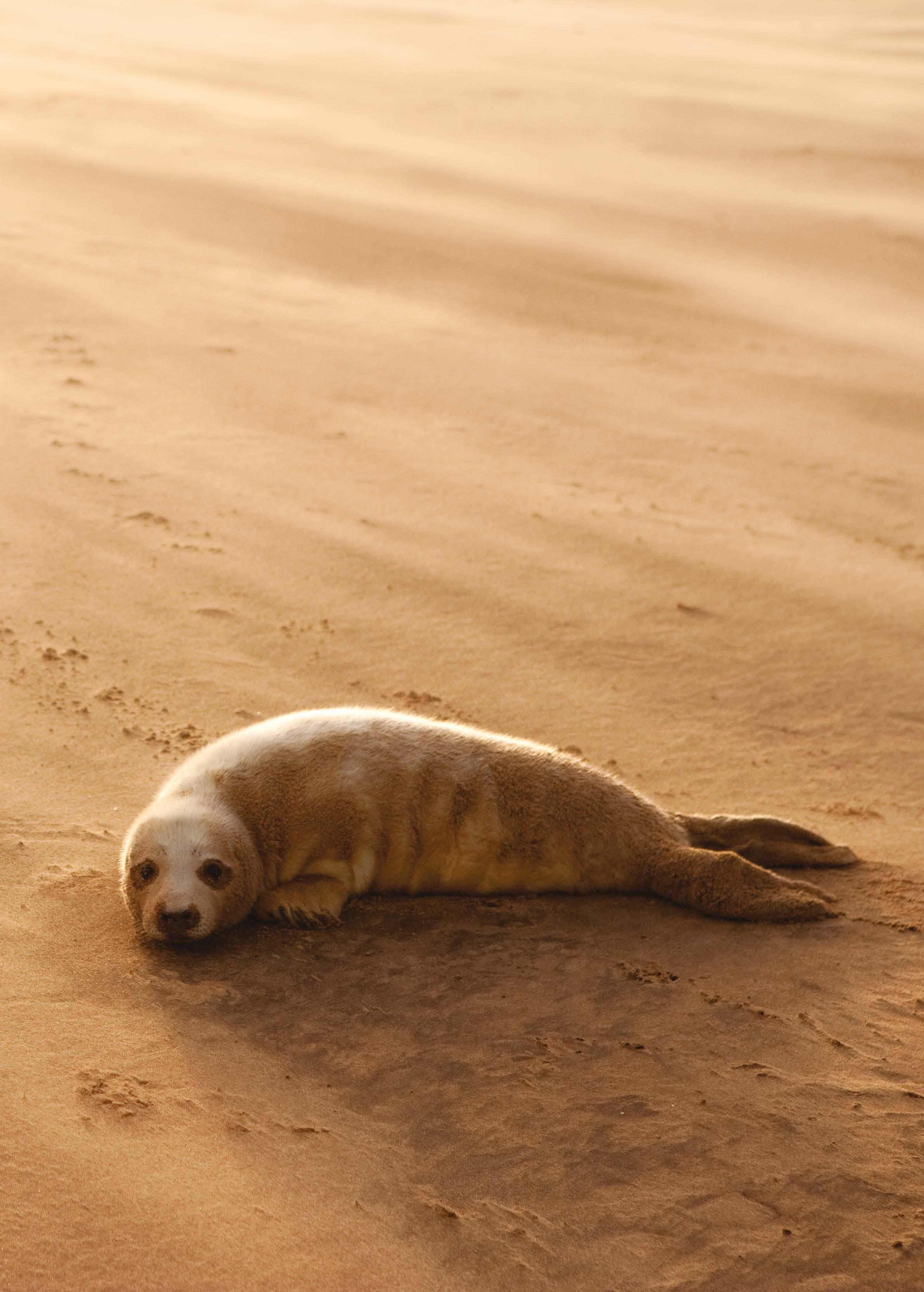
Grey seal pups are born in winter when our weather is at its harshest
Surrey Nature | Autumn 2022 31
Winter might seem a bad time to give birth in the wild but, as Lisa Morgan reveals, it’s prime pupping season for grey seals.
GREY SEAL PUP © DANNY GREEN/2020VISION
Why wait for cold weather?
Grey seals come ashore to give birth in autumn and winter, in a colony known as a rookery. The timing of the pupping season varies slightly around the UK. The Welsh rookeries are often the first to see pups, with the earliest arriving in August. There and in southwest England, the season peaks in September and is largely over by October. In eastern England and Scotland, the season starts a little later and can extend into January or February. Autumn and winter are known for their severe weather, so it seems like a strange time to give birth. It can certainly be hard to watch pups struggling to survive big seas and winter storms, exposed to the elements at the most vulnerable stage of their life. As recently as 2017, west Wales was pummeled by a relentless run of
the females — called cows. Raising a pup is a big commitment in terms of energy. A cow seal will use up to 30,000 calories a day whilst suckling her single hungry pup. However, the real issue is that she has to do all of this whilst fasting! Females rarely stray far from their pup, so don’t get to feed and top up their energy reserves. As the pups get fatter, the mothers get thinner. In fact, they can lose over a third of their body weight.
This is a strategy called ‘capital breeding’. The cows rely on the energy that they collect and store before the breeding season starts. Summer brings calm conditions with plenty of prey, perfect for a seal to fatten up. By the end of the summer, the females are as fat and healthy as possible, so there’s no better time to raise a pup.
exceptionally powerful storms. Storm
Brian and Storm Ophelia struck at the peak of pupping season for Welsh grey seals, with devastating results. On some beaches, 90% of the pups were lost.
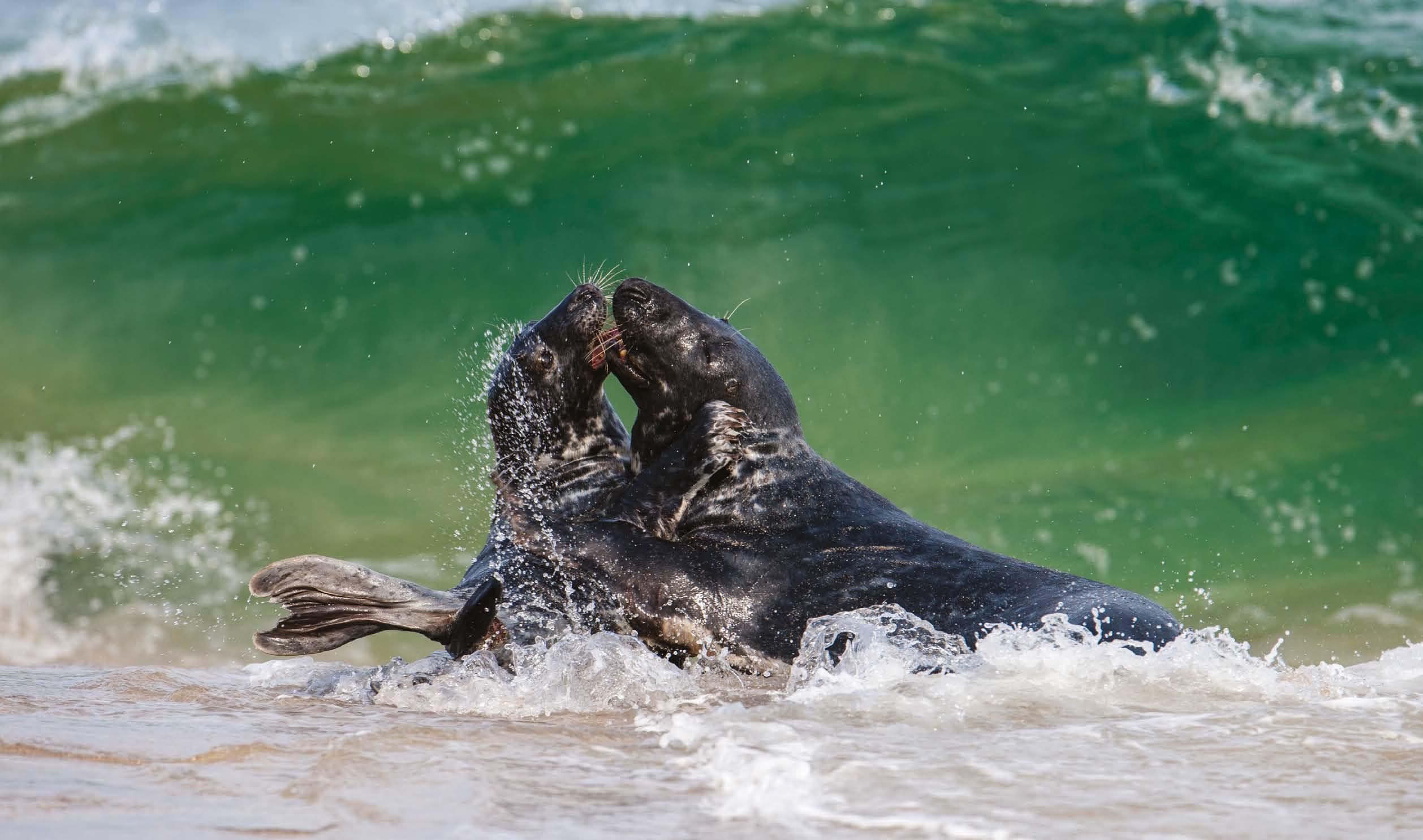
So why are grey seal pups born during one of the stormiest and most unpredictable times of year? It’s all about the condition of the adults, especially

Growing, growing, gone!
Seal pups don’t spend long on land. Cows suckle their pup for an average of just 18 days. A healthy pup with an attentive mother should triple its birth weight in that time, gaining around two kilograms a day. They grow so quickly thanks to the rich, fatty milk of the cow seal — which is more like cream at an incredible 60% fat.
32 Surrey Nature | Autumn 2022 FIGHTING SEALS © THE BIG PICTURE, NATUREPL; SWIMMING SEAL © ALEXANDER MUSTARD, NATUREPL
There aren’t many threats to young seals whilst they’re at their rookeries... but one thing they are vulnerable to is disturbance.
Surrey Nature | Autumn 2022 32
Bull seals will fight to control territories
When the cow decides she’s had enough and the pup is large enough, she abandons it and heads out to sea. The pup will remain in the rookery for a while, surviving on its fat reserves whilst it finishes moulting — pups are born with a fluffy white coat to keep them warm, but as they grow and build up a layer of insulating blubber, they shed their white fur for a darker coat. When hunger finally gets the best of it, the pup makes its way into the sea.
For a seal pup, feeding itself is all instinctive. It learns to find, catch, and eat food without any instruction or help from its mum. It’s a tough challenge, and not all pups survive this vulnerable time. The mortality rate of pups in their first year can be pretty high, depending on how bad the sea conditions are that winter. The pups that do make it through their first year could go on to live for 25 to 35 years.
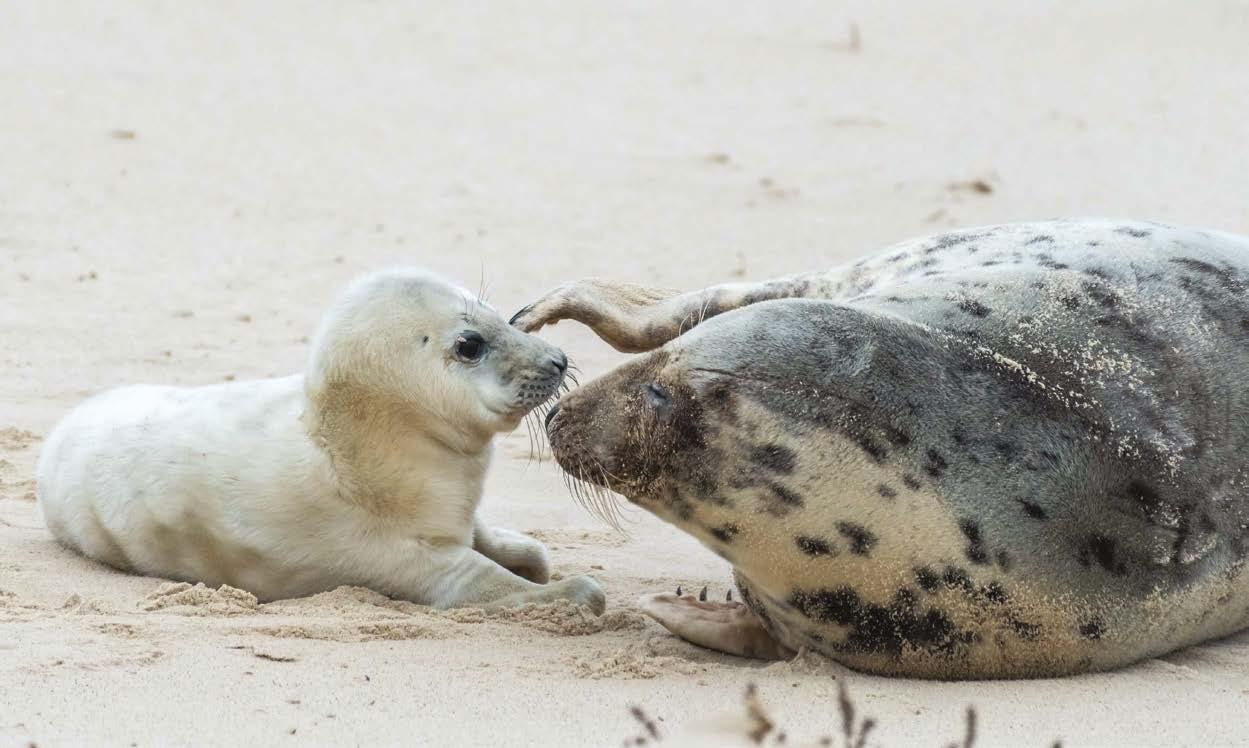
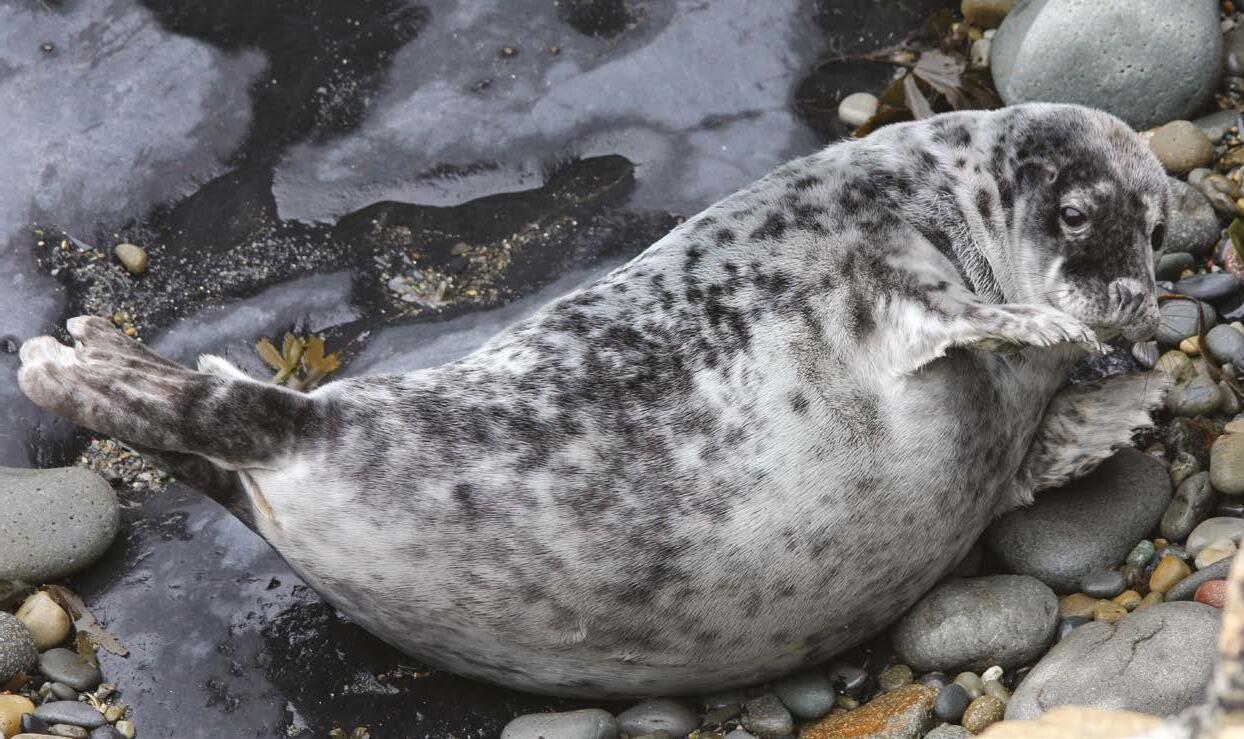
It’s not just females that come ashore in autumn. Male seals, known as bulls, also haul themselves out at rookeries. They fight each other to hold territories, hoping to mate with the females within that territory. Females come into season 14 days after giving birth, so will still be suckling pups as males try to mate with them.

With bulls reaching two metres long and weighing over 230 kilograms,
battles can be brutal. They wrestle on the water’s edge, biting each other on the thick skin around the neck, often drawing blood. Eventually the loser will retreat, chased into the water. The biggest bull seals will be the most successful, holding the best rookeries and mating with the most cows. They are called beachmasters. They hold their territory for as long as they can (usually around two weeks) before returning to the sea to feed. As with the females, they are fasting during this time so also lose a lot of weight.
Seal safety

There aren’t many threats to young seals whilst they’re at their rookeries, beyond the dangers of stormy weather and the occasional bull fight getting out of hand. But one thing they are vulnerable to is disturbance. Where possible, seals prefer places far from people. In Wales they often use pebbly, cliff-backed beaches that can only be reached from the sea. In the northeast of England and eastern Scotland many seals haul themselves up onto low, flat, grassy islands just off the coast. But if inaccessible spots aren’t available, they will happily use more open areas. Some of the UK’s biggest grey seal rookeries are on beaches in the east of England.
Seal pregnancies last about nine months, but cow seals have the amazing ability to effectively pause their pregnancy. In a process called delayed implantation, the fertilized egg stops growing and doesn’t implant on the uterus wall. A few months later, once the cow has had time to recover from the efforts of suckling a pup, the embryo implants in the wall and starts growing again. Around nine months later, the cow is ready to give birth.
It’s important to give seals some space. Spooking them by getting too close on foot, on the water with kayaks or paddleboards, or in the air with drones, can cause females to stampede into the water, putting pups at risk. In some cases, it can even lead to pups being abandoned. The seal season is one of our greatest wildlife spectacles, but it’s one that’s best enjoyed from a respectful distance.

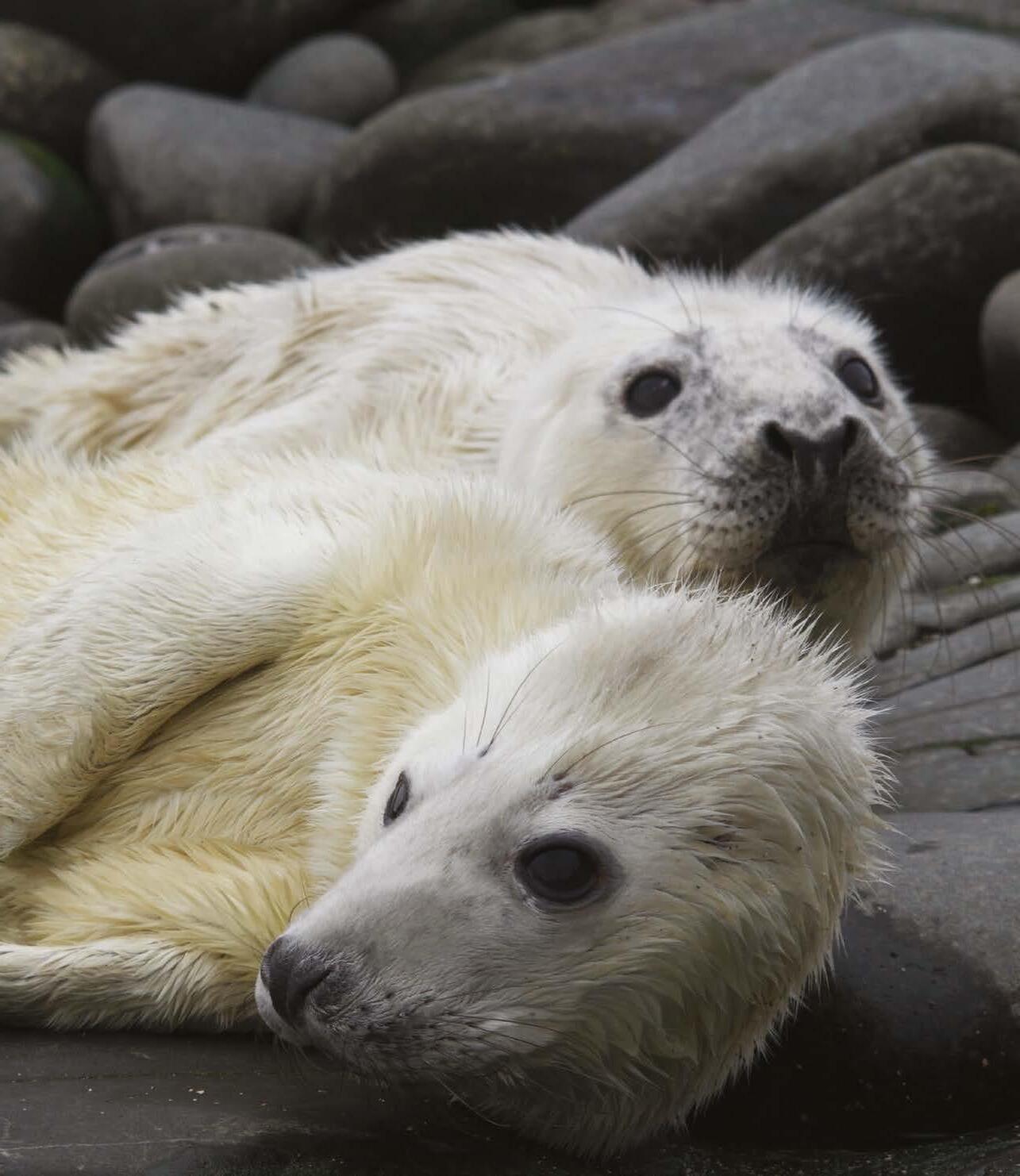
Surrey Nature | Autumn 2022 33
“Despite having seen hundreds of births, I still get the same tingle of emotions for each one.”
MOULTED PUP © LISA MORGAN, PUP AND COW © THINESH THIRUGNANASAMPANTHAR, TWO PUPS © TOM HIBBERT
Cow seals will stay with their pups for just 18 days
Once they have moulted, pups make their way to the sea in search of food
Grey seal pups are born with thick, fluffy coats to keep them warm
Surrey Nature | Autumn 2022 33
Discover some of The Wildlife Trusts’ top spots for seal watching at wildlifetrusts.org/seal-pups
There’s a busy market for deadwood dwellings!
stumps, and fallen trees are all in hot demand. This prime real estate is home to a huge variety of wildlife. There’s a fantastic range of properties in our deadwood portfolio, from the high-rise to the sprawling single -storey. These habitats all play an important role in the nutrient cycle, help to lock up carbon, and even improve the stability of our soils. Interested in seeing the particulars? Then let’s go on a viewing and get to know the neighbourhood!
Chloë Edwards is direc tor of nature recover y at Her ts & M iddlesex Wildlife Trust Chloë is a deadwood enthusiast and loves mar velling at the life in the various deadwood features she’s nur tured in her garden

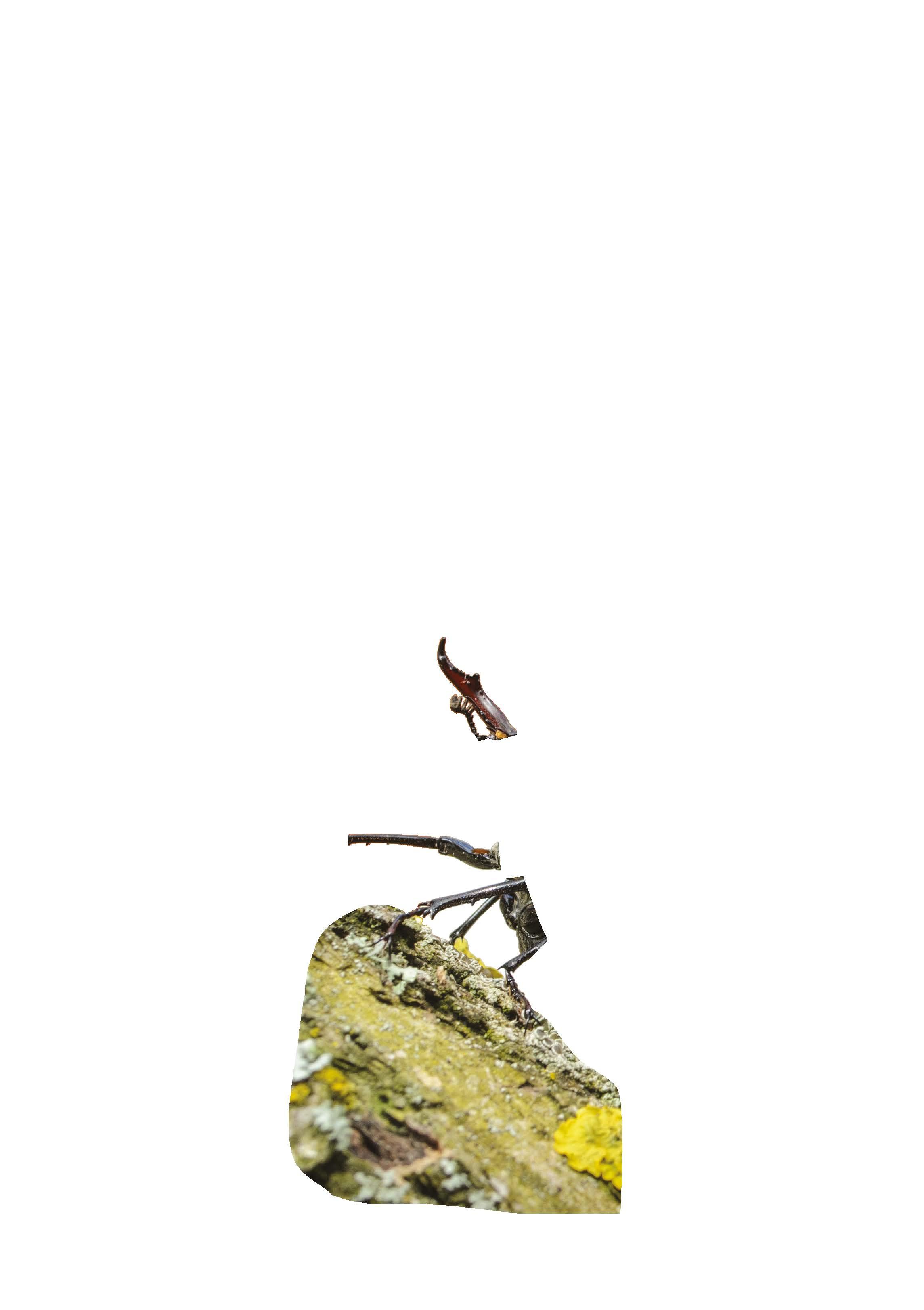
S T A G BE E T L E © TER R Y WH I T T AKE R /202 0 V I S I O N , W OODE N SI G N © S I T T I P ON G_ SRI K AN Y A , IS T OC K
Family-friendly environment
Neighbourhoods rich in dead and decaying wood are home to incredibly diverse communities. Many of the residents are invertebrates and fungi that play an important role in breaking down wood. A lot of them are entirely dependent on dead or decaying wood for at least part of their life cycle — we call this saproxylic. Some of our most recognisable insects are saproxylic.
The larvae of the majestic stag beetle favour basement locations in underground deadwood, whilst black and yellow longhorn beetle larvae are long-term tenants of fallen branches, taking up to three years to leave their home as adults. Finding the ideal location for a young family is also high on the house-hunting agenda for the batman hoverfly. It seeks out rot holes in trees where wet, decaying wood makes an ideal nursery. Fungi that thrive in these locations range from the delicate stalks of candlesnuff fungus to the chunky chicken of the woods.
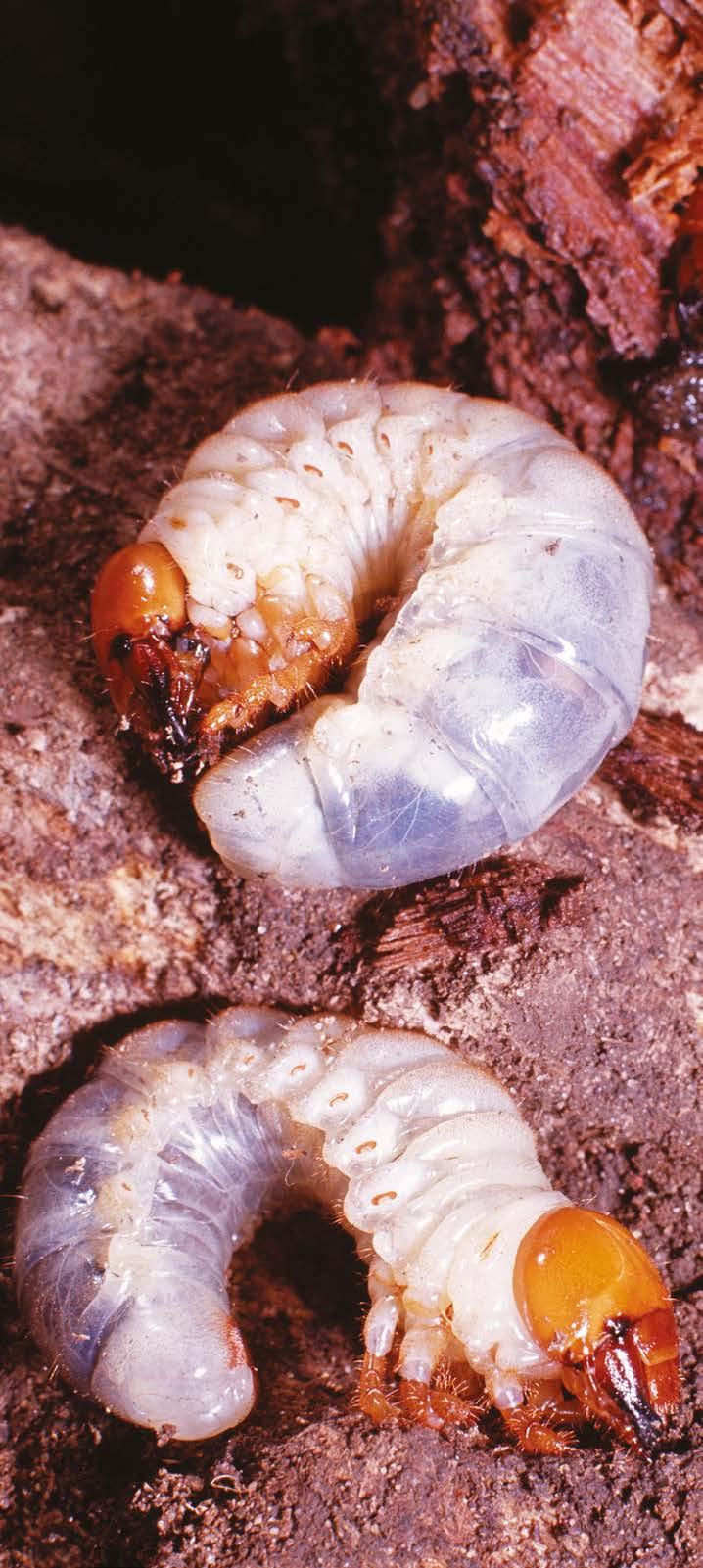
Location, location, location…
A third of all woodland birds nest in the hollows or cavities of dead trees. Great spotted woodpeckers drill their own holes, whilst nuthatches and tawny owls seek out existing gaps. Other birds of prey will use standing dead trees as a lookout post, or for somewhere to devour their prey.

Many of our bat species search for trees with lots of character (cavities, rot holes, fissures, and splits) in which to roost. Our biggest bat, the noctule, isn’t put off by a pre-loved home. They often favour old woodpecker holes. The rare and elusive barbastelle bat, found only in woods with plenty of standing deadwood, often takes advantage of spaces behind lifted, flaky bark plates.
They are not alone in the vertebrate community in finding deadwood attractive. Through the seasons, many amphibians and reptiles will be taken with the charm of a log pile. Its amenities include shelter, a lookout point, somewhere to bed down, a sun lounger, and so many opportunities for eating out right on the doorstep — deadwood has it all!
On the water
It’s not just land-lovers who appreciate deadwood. Fallen logs in rivers can provide the perfect refuge for fish and a whole host of aquatic invertebrates. They can also be a spraint spot for an otter, or a perch for a kingfisher. They even act as natural dams and can slow the flow of a river or stream, reducing erosion and holding water back in times of heavy rain, helping to make the landscape more resilient.
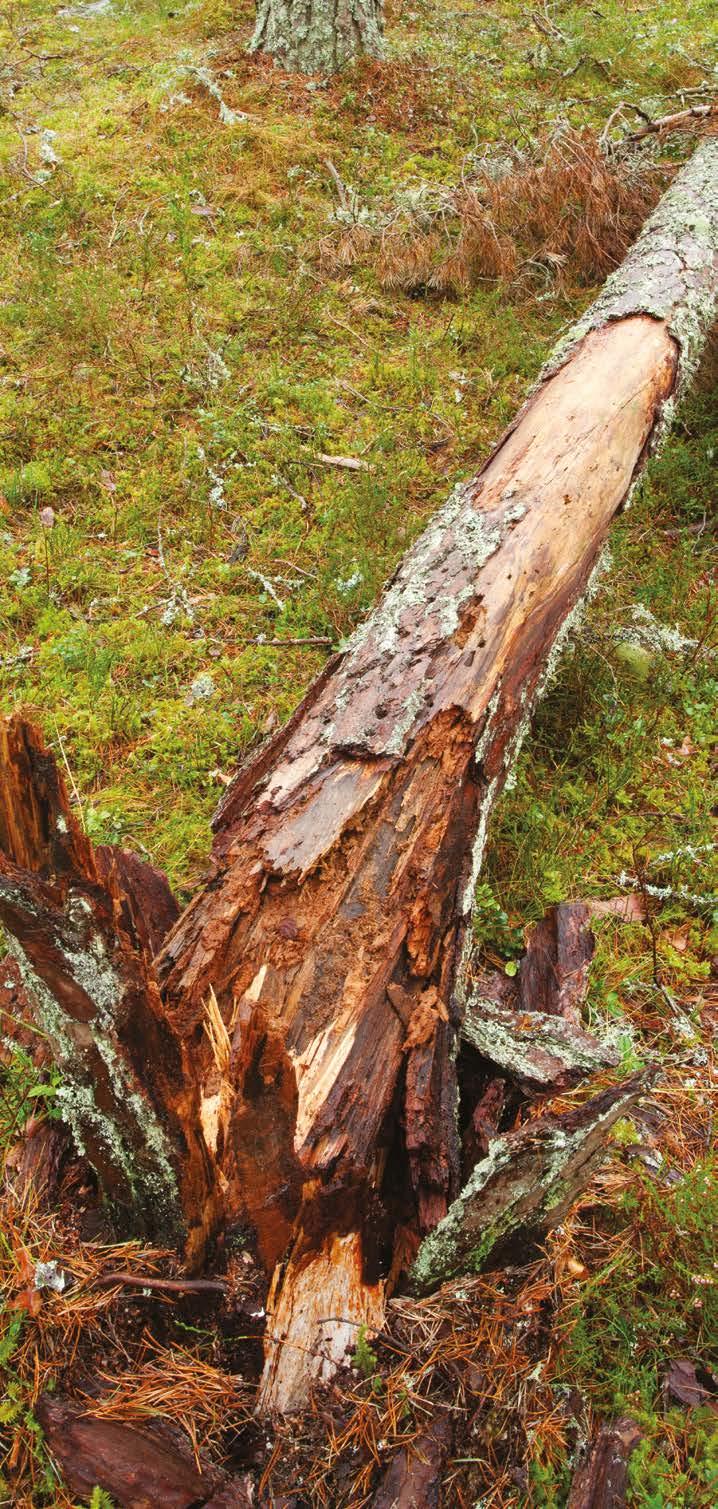
Your next move
With 13% of all plants and animals known in the UK directly dependent on deadwood habitats, it’s a vital component of our landscapes. We must respect it, protect it, and seek to create more of it! Make a garden more appealing by creating a log pile. If you have a tree stump in the garden, leave it for your new wild neighbours to move into. Pop out the welcome mat and wait to see who turns up to the housewarming!
For tips on making a deadwood dwelling visit wildlifetrusts.org/log-shelter

Magazine Name | Winter 2022 3 STAG BEETLE LARVAE © JANE BURTON, NATUREPL.COM; LOG PILE © SCOTT PETREK; FALLEN SCOTS PINE © MARK HAMBLIN/2020VISION; NUTHATCH © NEIL ALDRIDGE
ROT PROPERTY Surrey Nature | Autumn 2022 35
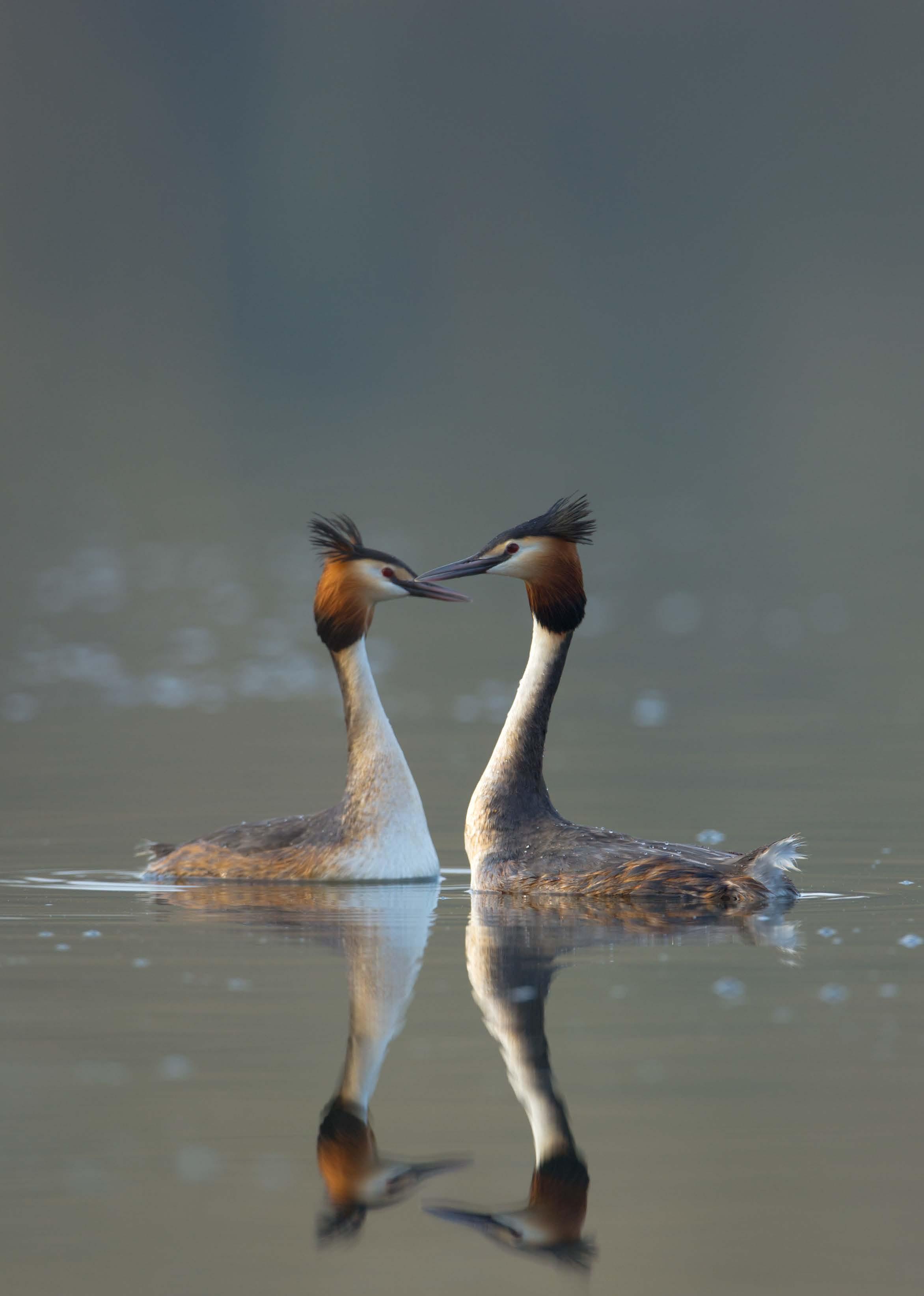
Andrew Parkinson/2020VISION Leaving a gift in your will can help us to protect nature and inspire future generations to love it too surreywildlifetrust.org/legacies Your love of You can also call us on 01483 795445 or email fundraising@surreywt.org.uk live on nature can Surrey Wildlife Trust

















 Wild Youth team © Laura Ashfield, SWT
Wild Youth team © Laura Ashfield, SWT











 Mike Waite, SWT director of research and monitoring
Mike Waite, SWT director of research and monitoring













 © Adobe / F_studio
© Adobe / F_studio

































